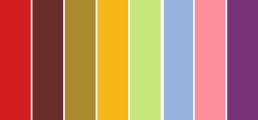The changing role of design
November 20, 2023Custom Giftsgraphic design,design
It’s time to put creativity back into design again
“Design has become a cottage industry.”
The owner of a critically acclaimed design agency lamented at a board meeting of an industry organization a few years ago. They were referring to the fact that they were facing a hard time charging the kind of expensive fees it once used to command and were now often having to compete with independent designers who were willing to do the same job at a fraction of the cost.
This design agency no longer calls itself a design agency. Its website says “We are a transformation consultancy.”
In another conversation with a different design agency owner, I asked them what the turning point in their career was.
“It was when we stopped positioning ourselves as a design agency.”
They were known for beautiful brand identity, packaging, and design systems work but the owner said they started to take on more advertising and marketing work because budgets were better and they could command higher fees. This answer did and didn’t surprise me.
In more recent weeks, a few other comments and headlines caught my eye.
On a panel discussion at a Bloomberg conference about the future of business two weeks ago, Jeffrey Katzenberg, the former chairman of Walt Disney Studios, the founder of DreamWorks Studio and other successful creative ventures, said he believes that AI will lower the cost of producing blockbuster animated feature films by 90%. “It used to take 500 people over five years to make one really good animated film. Now, we can reduce that by 90%.” I believe he’s right.
And just last week, the world’s most famous consultancy synonymous with the word design laid off one-third of its staff. With it, a Fast Company article unofficially declared the end of the era of design thinking.
All of this isn’t new news. There have been various articles about how design thinking has fallen out of favor in Corporate America or where it went wrong. The topic has been on our collective minds for a while now.
Design, as an industry, has slowly been devolving and decaying for the past decade or more.
Design vs. design thinking
The word “design” is a suitcase word.
A term coined by the late Marvin Minsky, the co-founder of MIT’s artificial intelligence lab, “suitcase word” is used to describe the type of words into which people attribute or pack multiple meanings. A suitcase word “means nothing by itself, but holds a bunch of things inside that you have to unpack,” observed Minsky.
One of the definitions of design that I’ve always appreciated comes from Dieter Rams, the former head of design at Braun and Vitsoe and the industrial design giant of the 20th century, known for his functional, clean, unobtrusive design aesthetic that placed priority on usefulness over superficial styling. If you haven’t heard his name before, you certainly have come into contact with designs that were heavily influenced by him. Take any Apple product of the last 25 years and we can see his influence.

His definition of design isn’t a definition per se but it’s a set of principles. He calls them Ten Principles for Good Design. Even though his domain of expertise was industrial design, most of his principles could apply to modern, digital products.
- Good design is innovative
- Good design makes a product useful
- Good design is aesthetic
- Good design makes a product understandable
- Good design is unobtrusive
- Good design is honest
- Good design is long-lasting
- Good design is thorough down to the last detail
- Good design is environmentally-friendly
- Good design is as little design as possible
Design thinking, unlike the word design, has a clearer definition, for better or worse. It’s taken one suitcase word and attached another to create a term and an explanation that people could understand. It proposed a set of steps for design that anyone-particularly Corporate America-could follow:
The goal of design thinking was to involve users in the process, work quickly to build and test prototypes, and iterate based on feedback. It claimed that this human-centered-another buzzword-process leads to innovative solutions.
The term has been around for close to half a century but it was IDEO that popularized the term around 2007. It was driven by Tim Brown, its former, long-time CEO, with his Harvard Business Review article, a TED talk, and a book. It’s one of the best brand activations for and by a professional services firm of the last two decades.
Brown crafted a gospel of design thinking that Corporate America as well as elite universities could sing. Many are still singing it. When Hakuhodo DY Holdings, the second largest advertising holding company in Japan bought a sizable stake in the company for millions of dollars in 2016, it never thought that the darling of design thinking and its gospel would get stale in less than a decade. To be fair, the rest of the world didn’t think so either.
The fortunate thing about design thinking was that it democratized design by making everyone feel like they can be a designer, or at least be a significant part of designing. At the risk of sounding like a creative elite, I’ll say this: it was successful in making non-creative organizations feel like they could be creative.
Design thinking leveraged Post-it notes as a vehicle for making collaboration accessible, visible, and repeatable, and making it easy for Corporate America to adopt it. Post-it notes became so ubiquitous that they started to appear, somewhat awkwardly, in the digital space in many online collaboration tools.

Using a metaphor to design interfaces has its upsides and downsides. The computer desktop interface is one such example. Interface designers in the 1970s and 80s took the physical desktop as a metaphor to recreate a workspace on-screen. It was effective in wrapping our heads around an abstract digital directory system and made a visual and graphical user interface, GUI.
But the downside is that it also replicated the ugliness of the physical world. That is why our computer desktops remain messy unless we meticulously organize them. It’s freaking four decades after the computer desktop interface was invented and it still hasn’t been fixed. Ok, I digress. Back to the topic.
Having participated in numerous design thinking workshops and processes, including the ones facilitated by the said consultancy for shared clients, I will admit that this type of methodology was effective in making them feel like they were part of the process.
But oftentimes, I felt underwhelmed by the outputs. They were either small ideas that tweaked the previous products and services, or fictional fantasies that would look good in vision presentation videos in corporate boardrooms but were not practical or implementable. That explains why certain versions of design thinking leave the final step of “Implement” out of the process.
The underlying message of design thinking was “everyone is creative.” It’s a good thought.
Design thinking made design more approachable for everyone by putting more emphasis on the thought and process of design but less on the craft of it. This meant that you didn’t need to have years of experience in designing things yourself. The phrase also implied that there was not much thinking in the discipline of design itself, thus relegating it to a lower status.
Over time, it started to over-emphasize making the team feel good but deemphasize making them accountable for the quality of the idea or the output.
The problem with design thinking, particularly in the last decade, was that it became toomuch about thinking and not enough about the act of making or designing.
Does design still matter?
If we look at some of the fastest-growing digital products of the past 12 months, the role of designers and design thinkers may not be so obvious, apparent, or even significant.
One such example is Threads.
I’m sure there were many designers involved in making this product possible. However, there is very little original thought in this product. I mean no disrespect to the designers who worked hard on it-particularly as I have good friends working at Meta. We all know that the decision to copy an existing product didn’t come from a designer or the process of design thinking. It’s a replica of an existing successful product. They didn’t need a brilliant designer or design thinker for it.
It’s an opportunistic product at its best.
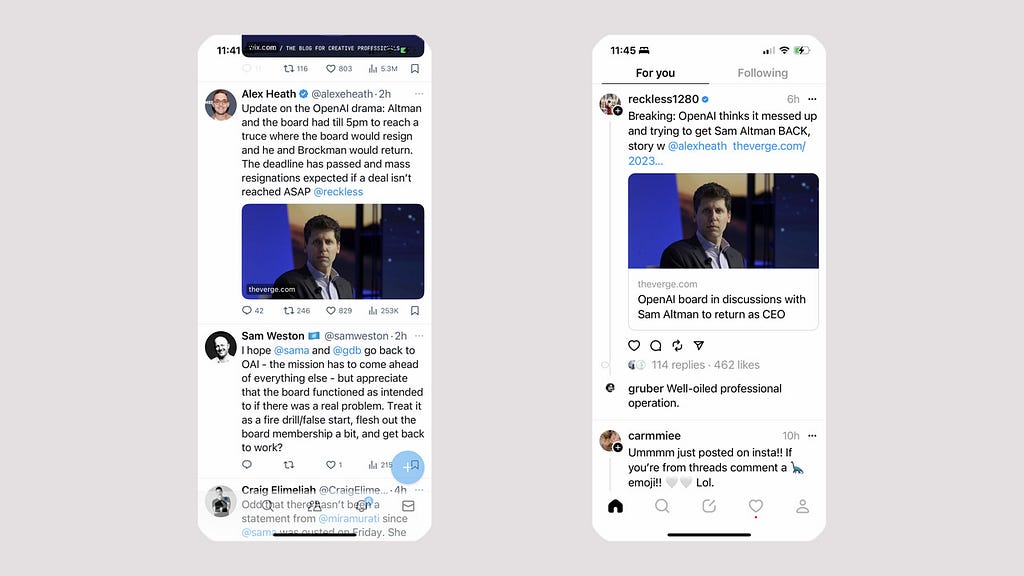
There are two factors that I believe made Threads successful, both of which have very little to do with design.
First, its timing.
Although we might have been a little curious about what the takeover by Elon Musk of Twitter could “unlock” for the platform, not many of us predicted that it would be the debacle that it has become. Mark Zuckerberg’s launch announcement didn’t make any mention of that but it was written all over it: he cunningly capitalized on the demise of a competitor product. A textbook demonstration of functional speed in business.
The other factor is its lack of innovation. Threads didn’t try to reinvent a new paradigm of communication or even a new feature that would differentiate the product from its original. Meta restrained from overdesigning Threads and stuck to the bare minimum.
Every feature change and hateful comment on Twitter/X is now a gift to Meta that keeps on giving. It goes back to the first factor. Its timing couldn’t have been better.
Where I see the evidence of design in Threads is its integration with Instagram.
If we had an Instagram account, signing up for Threads was instant. It’s a step 99% of new digital products struggle with. In addition, the way Threads posts appear as intermissions within one’s Instagram Feed is natural and feels unobtrusive.
Per one of Rams’ principles, this is good design. However, if we designers are happy at this level of contribution to a product, we are really underselling ourselves and thinking way too small.
Different > Better
Anyone who practices the craft of design knows that we like to draw invisible lines between us and those who aren’t but claim to be.
Let’s be honest. We designers judge those who use Canva instead of Figma. Or even Wix instead of Squarespace. Or WordPress for the more tech-savvy.
While Generative AI is creeping into Figma’s and Photoshop’s of the world, it’s also infiltrating Canva’s and Wix’s, the tools that non-designers use. Everyone, whether you are a designer or not, can now do something that is not just decent but pretty good. AI lowers the bar for non-designers.
Does that mean that anyone can be a designer and everyone can be a creative? Yes, but it doesn’t matter.
Such classification of our professions is becoming less relevant because anyone with no discernible talent or skill can generate decent stuff. The good and bad news is that AI is deindustrializing creative professions as we have known them.
Then, the question is how creative are we designers really?
If our work is similar to everyone else’s, we might as well be just operators of tools.
Being creative means the work we produce is not only better than others but is different and has a distinct point of view.
It’s time to put creativity back in design again.
Thanks for reading. If you like what you read, please subscribe to The Intersection, my weekly newsletter that explores what the future holds at the intersection of creativity and technology.
Originally published at https://reiinamoto.substack.com.
The changing role of design was originally published in UX Collective on Medium, where people are continuing the conversation by highlighting and responding to this story.
Looking for cool gifts? Check Rott515 store!
Naruto Merch: The must-haves for every fan
November 18, 2023tshirts,gifts,custom gifts,aviation,Custom Gifts,funny tshirts,funnyrott515
Welcome to the world of Naruto
For those unfamiliar with the series, here’s a brief introduction: Naruto, also known as “Naruto: Shippuden”, is one of the most popular anime and manga series of all time. The story is about Naruto Uzumaki, a young ninja with the goal of becoming the most powerful Hokage and protecting his village from dangerous enemies.
The story begins with Naruto as an orphan who is often shunned and despised by his fellow villagers in Konoha. The reason? A powerful demon, the Kyuubi, is sealed inside him. Despite the prejudices and difficulties he encounters, Naruto strives to become the strongest ninja and gain recognition. In the process, he makes friendships that will change his life forever.
The series is packed with action, friendship, exciting fights and unforgettable characters. Naruto is accompanied by his friends Sasuke and Sakura and their journey takes them on dangerous missions against powerful opponents. In the process, they not only learn about the world of ninjas, but also about themselves and the importance of friendship and sacrifice.
No wonder the series fascinates so many people around the world. The captivating storyline, the deep characters and the messages of perseverance, friendship and self-discovery make Naruto a timeless series that has inspired and continues to inspire generations of fans. If you’re not yet familiar with the world of Naruto, you should definitely take a look, because it has the potential to enrich your life and captivate you with its stories.
The hype surrounding Naruto
The hype surrounding Naruto has only grown in recent years. Fans all over the world have fallen in love with the adventures of Naruto, Sasuke, Sakura and their companions. The series not only has a huge following of anime and manga fans, but also people of all ages and backgrounds.
The characters and in-depth stories in Naruto have captured the hearts of fans. The young Naruto, who perseveres against all odds to pursue his dreams, speaks a message of determination and self-confidence that inspires viewers young and old alike. Sasuke, who is driven by revenge and becomes entangled in a deep inner conflict, illustrates the complexity of human emotions. Sakura, the strong and confident kunoichi, teaches us that gender doesn’t matter when it comes to rising above yourself.
The stories in Naruto are characterized by unforgettable lessons and dramatic battles that keep viewers on the edge of their seats. Each battle and mission presents not only ninja techniques and strategies, but also important moral lessons. The messages of perseverance, friendship and self-discovery are universal and timeless. This special connection to the characters and storyline has led to many people looking for ways to show their affection for the series.
Fans have not only taken the manga and anime series to their hearts, but also the numerous movies, novels and video games that expand the Naruto universe. Conventions and cosplay events have helped to strengthen the Naruto community and take enthusiasm for the series to a new level.
Whether you’ve been following the series since its release or are just diving into the world of Naruto, the hype and excitement surrounding this series is definitely contagious. The deep characters and exciting stories have created a large and diverse fanbase that is eager to see and experience more of their favorite characters.
Naruto merchandise: Express your passion
Thanks to Speadshirt, you will soon be able to express your passion for Naruto in a very special way. Our platform will soon be offering a wide range of officially licensed Naruto fan merchandise. You will find, among other things:
- Shirts: show your allegiance to your favorite team or character with stylish Naruto shirts.
- Caps: Protect yourself from the sun while showing your enthusiasm for the series with Naruto caps.
- Sweaters and hoodies: Keep warm and cozy with Naruto sweaters and hoodies.
- Mugs and cushions: Decorate your home with Naruto mugs and cushions to add a special touch to your home.
- Buttons and stickers: Customize your clothing and accessories with Naruto buttons and stickers.
- Gym bags and aprons: Carry your belongings in style in a Naruto gym bag or impress while cooking with a Naruto apron.
- Posters: Adorn your walls with stunning Naruto posters that show your love for the series.
The magic of Naruto collectibles
The world of Naruto is full of fascinating characters, from the main characters Naruto, Sasuke and Sakura to the legendary Sannin and the mighty Kage. With Naruto fan merchandise, you can create a personal connection with your favorite characters. Whether you identify with the determination of Naruto, admire the strength of Sasuke or appreciate the intelligence of Shikamaru, there is merchandise to express your enthusiasm.
Fan merchandise allows you to express your personality and preferences in subtle ways. A Naruto shirt or cap shows the world what you stand for without having to say a word. You can spice up your style with Naruto hoodies, sweaters and accessories to add a personal touch to your outfit. With Naruto buttons and stickers, you can personalize your belongings and add a touch of ninja magic to your everyday life.
Naruto fan merchandise is both a fashion accessory and a valuable collector’s item. The high quality and official licensing make them coveted items for fans all over the world. A Naruto poster can transform your room into a scene from the ninja world, while a collection of mugs and cushions can turn your home into a cozy ninja village. These items are not only an expression of your passion, but also precious mementos that you will cherish for years to come.
What every Naruto fan needs
Why should you invest in Naruto merchandise? Well, aside from the obvious opportunity to show off your love for the series, these products are high quality and durable. They are officially licensed and made with great care to ensure they meet the demands of a true fan.
The merchandise also allows you to connect with other Naruto fans. They serve as conversation starters and show that you are part of the Naruto community. They also help to support the series and ensure that more great content is produced in the future.
Our verdict: If you’re a true Naruto fan, then these fan items are an absolute must-have. You’ll soon be able to purchase these fantastic Naruto merchandise items from Speadshirt and expand your fan collection. What are you waiting for? Show the world your love for Naruto!
Der Beitrag Naruto Merch: The must-haves for every fan erschien zuerst auf Create Blog.
Looking for cool gifts? Check Rott515 store!
Design a Movember outfit and promote better men’s health
November 16, 2023tshirts,gifts,custom gifts,aviation,Custom Gifts,funny tshirts,funnyrott515
What is Movember and what does it stand for?
Movember is an annual health campaign that takes place in November and aims to promote men’s health worldwide. Originating in Australia, Movember has evolved into a global movement that tackles various health issues including prostate cancer, testicular cancer, mental health and suicide prevention. The name “Movember” is made up of the words “moustache” and “November”. While participants are encouraged to grow a moustache for the entire month of November, it’s not just about appearance, but more importantly about raising awareness for men’s health and raising funds for related research and programs.
Movember was originally created to raise awareness of prostate cancer, as prostate cancer is one of the most common cancers in men. Over time, the focus of the movement has expanded to address other health issues that affect men, such as testicular cancer and mental health. In addition, suicide prevention plays a central role in the Movember movement, as men are at an increased risk for suicidal behavior.
The movement has evolved into a global community where people of all genders and ages come together to promote men’s health. Movember aims not only to encourage men to take care of their health, but also to break the taboo surrounding men’s health issues. Fundraising is a crucial aspect of the movement as it funds research and programs that can ultimately save lives.
Overall, Movember stands for solidarity, prevention and support. It encourages people to take an active role in men’s health, whether it’s by grwoing a moustache, donating or raising awareness. And self-designed Movember outfits, especially customT-shirts, can be a unique way to participate in this important movement while spreading the message of men’s health.
Design a Movember outfit and be part of the movement
Designing a Movember outfit is a creative and effective way to raise awareness about men’s health. Here are some ideas on how to create your own Movember outfit, especially custom t-shirts:
Designing the perfect Movember outfit: Self-designed T-shirts
Design T-shirts that are individually tailored to your preferences and messages. Give your creativity free rein to create unique designs. Use motifs that include moustaches or inspirational messages about men’s health. You can wear these T-shirts for the whole month of November and make them an unmistakable symbol of your support for Movember.
- Creative details: You could, for example, enhance your self-designed T-shirts with creative details such as sequins, glitter or fabric paint to make them even more unique and eye-catching.
- Community design: Getting creative as a community by organizing Movember t-shirt design events with friends or like-minded people can also be a great idea for Movember. Together you can brainstorm ideas and create unique t-shirts that share the message of men’s health.
- Carry the message: Your self-designed T-shirts can carry a message that educates about the importance of Movember. You can incorporate information about preventing prostate cancer, the importance of early detection and supporting men with mental health issues into the design.
- Purple and blue clothing: The official colors of Movember are purple and blue. Wear clothing in these colors to show your support for the movement.
More Movember accessories and campaigns
- Fundraising campaigns: Use your self-designed T-shirts as a fundraiser. Sell them to friends, family and colleagues to raise funds for men’s health. This is a great way to not only spread the word, but also generate financial support for research and programs.
- Creative beard styling: If you have enough beard growth, you can style your beard Movember-style. Use beard care products and create impressive moustache and beard shapes.
- Social media presence: Share photos of your self-designed t-shirts and stylish beard on social media to spread the word. Use hashtags like #Movember to be part of the global movement.
Design a Movember outfit with Spreadshirt: simple, high-quality and stylish
Designing a Movember outfit with Spreadshirt offers numerous advantages that go beyond the simple creation of an individual look:
- Unleash your creativity: Spreadshirt offers a wide range of design options. You can let your imagination run wild and create a unique Movember outfit that reflects your personality. From the choice of colors and designs to the placement of messages and graphics – you have full control over your outfit.
- Focus on quality and comfort: Spreadshirt attaches great importance to the quality of its clothing. You can be sure that your self-designed T-shirts and accessories are comfortable and durable. This is especially important as Movember lasts the whole month and you want to make sure your outfit is comfortable to wear.
- Emphasize individuality: Movember is all about individuality and expressing support for men’s health. By customizing your Movember outfit through Spreadshirt, your look will stand out from the rest. You can be sure that no one else has an identical outfit, which helps to make the message stand out.
- Spread your message: Spreadshirt allows you to place messages and graphics on your outfit. You can include information on men’s health, the importance of early detection of cancer or support for men with mental health issues. Not only can you show off your personal style, but you can also draw attention to important health issues.
- Promote community: Spreadshirt offers the opportunity to work together on Movember outfits. You can collaborate with friends, family or colleagues to create uniform t-shirts or accessories that show solidarity for men’s health.
So if you want to make a statement for men’s health this November, consider customizing a Movember outfit through Spreadshirt. Show your support for this important movement, be creative and contribute to improving men’s health. With your customized outfit and your solidarity, you’ll be helping to raise awareness and save lives.
Der Beitrag Design a Movember outfit and promote better men’s health erschien zuerst auf Create Blog.
Looking for cool gifts? Check Rott515 store!
The best graphic design challenges for training your creativity
November 9, 2023tshirts,gifts,custom gifts,aviation,Custom Gifts,funny tshirts,funnyrott515
Challenges for designers are some of the best ways to get out of your comfort zone, develop your creativity and produce better work. Just like the muscles in your body, you can train and develop your design skills, too. Design challenges give your creative muscles an intense workout and take your work to a new level.
We’ve put together a few of the best challenges and games for designers – featuring everything from typography and graphic design to branding and illustration. Whether you’re a newbie or a seasoned professional, they’ll help you improve your current skills and try exciting new techniques. Read on, get involved – and find the challenge that gets your creative juices flowing.
The best design challenges
-
Daily UI Challenge
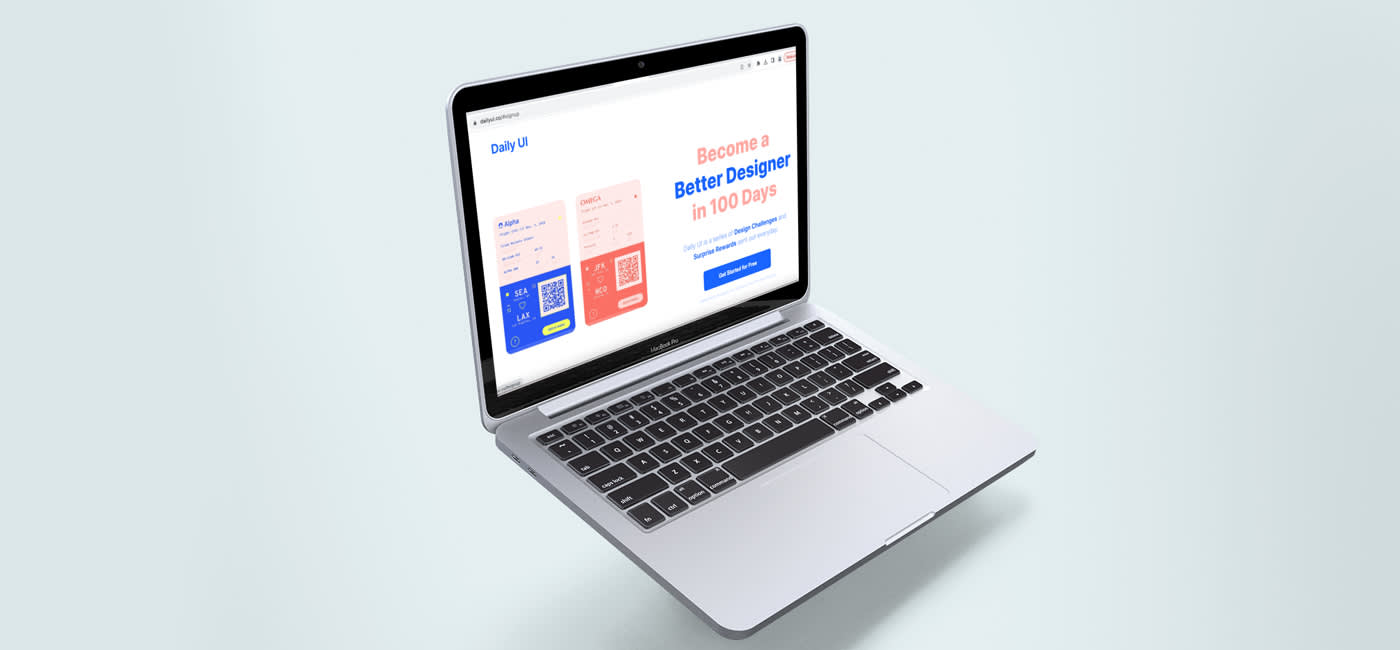
Who has a better understanding of the challenges designers face and the best designs than the design community itself? This was the inspiration for Daily UI. Since 2016, the network has created a daily design challenge to inspire graphic designers worldwide and help them put their skills to the test.
Now, more than 300,000 people from all sorts of disciplines take part. If you like, you can share your design using the hashtag #dailyui, or use it for your own portfolio. It’s completely free to take part – and as an added bonus, Daily UI gives away prizes such as vouchers and design tools, too.
-
Daily Logo Challenge
The Daily Logo Challenge is a popular design challenge. It’s free to take part – all you need to do is give your name and email address, and your creative journey is ready to begin. Every day for 50 days, you’ll receive a logo design challenge in your inbox – perfect for practising your skills or putting together your portfolio.
The Daily Logo Challenge regularly presents many people’s attempts on its social media channels, too. This allows those taking part to get feedback from other designers.
A fantastic opportunity to learn and grow together. With each day of the competition, you’ll take your skills in the fine art of logo design that little step further.
-
Inktober challenge
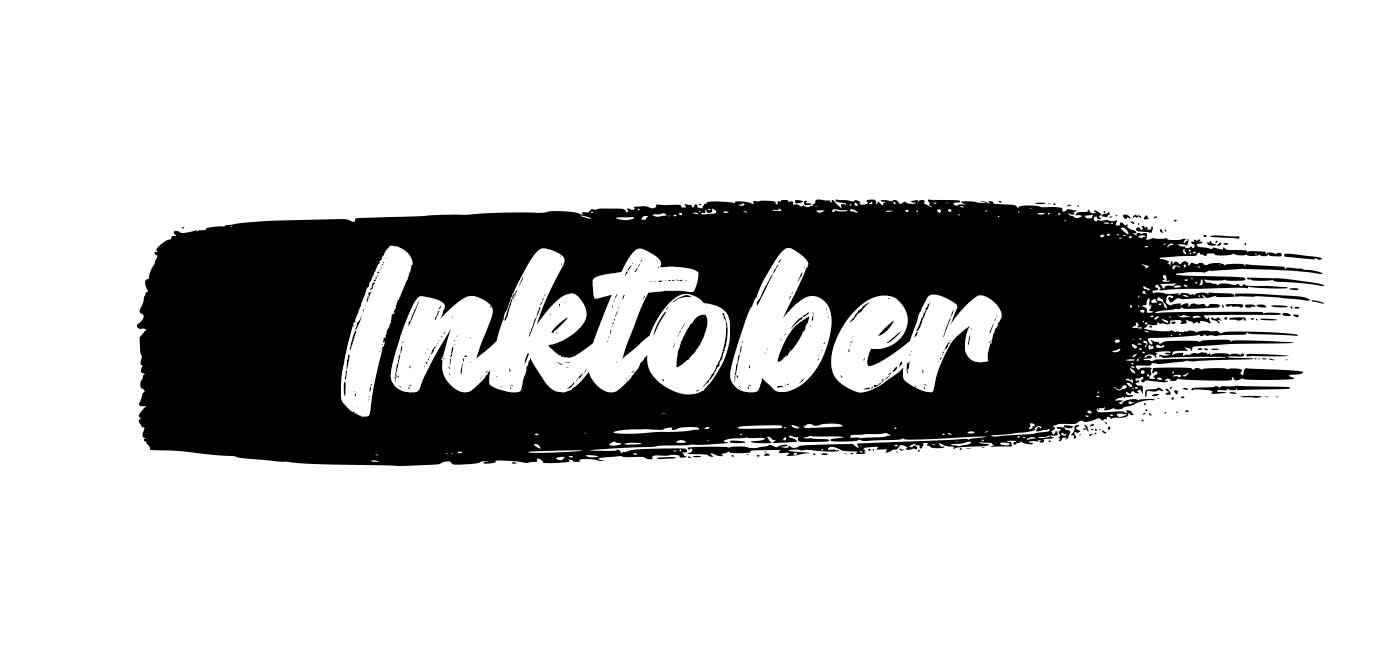
Inktober is an October illustration challenge for free spirits and creatives. Jake Parker brought this passion project to life back in 2009. The illustrator wanted to improve his colouring skills and develop positive drawing habits.
Thousands of people now take part in the challenge every year. A growing number use digital tools instead of pen and ink. The best thing about Inktober is there are no strict rules or ‘wrong’ ways to do it.
Inktober is a blank canvas where you can express yourself in every way you can possibly imagine. It frees you from the monotony of everyday tasks and stimulates creative flow.
There are two ways to take part:
- Inktober Classic runs from 1 to 31 October. Using the official Inktober prompt list, you’ll create 31 drawings in 31 days – which you can share on social media with the hashtags #inktober and #inktober24.
- Inktober52 is a longer-term project that’s a little more chill: every week for a year, you’ll be sent a prompt. You’ll use your prompts to complete a total of 52 drawings – which you can post online using the #inktober52 hashtag.
-
Vectober challenge
Inspired by Inktober, Vectober is a challenge for digital artists. Those who take part create an illustration using vector tools every day in October. However, there’s no central organisation for this challenge. So the most important thing is that you think about what you’d like to achieve. Then all you need to do is stay the course – and have fun too, of course!
Some creatives seek out their own subject matter or work with the Inktober list of prompts. Others set up their own Vectober challenge and use their example to inspire others.
That’s what Affinity user and vector expert Jhonatan Silva did in 2021 and 2022 – with his YouTube channel and the design school and community Vectorize Club, where you can find inspiration.
-
The 100-day challenge
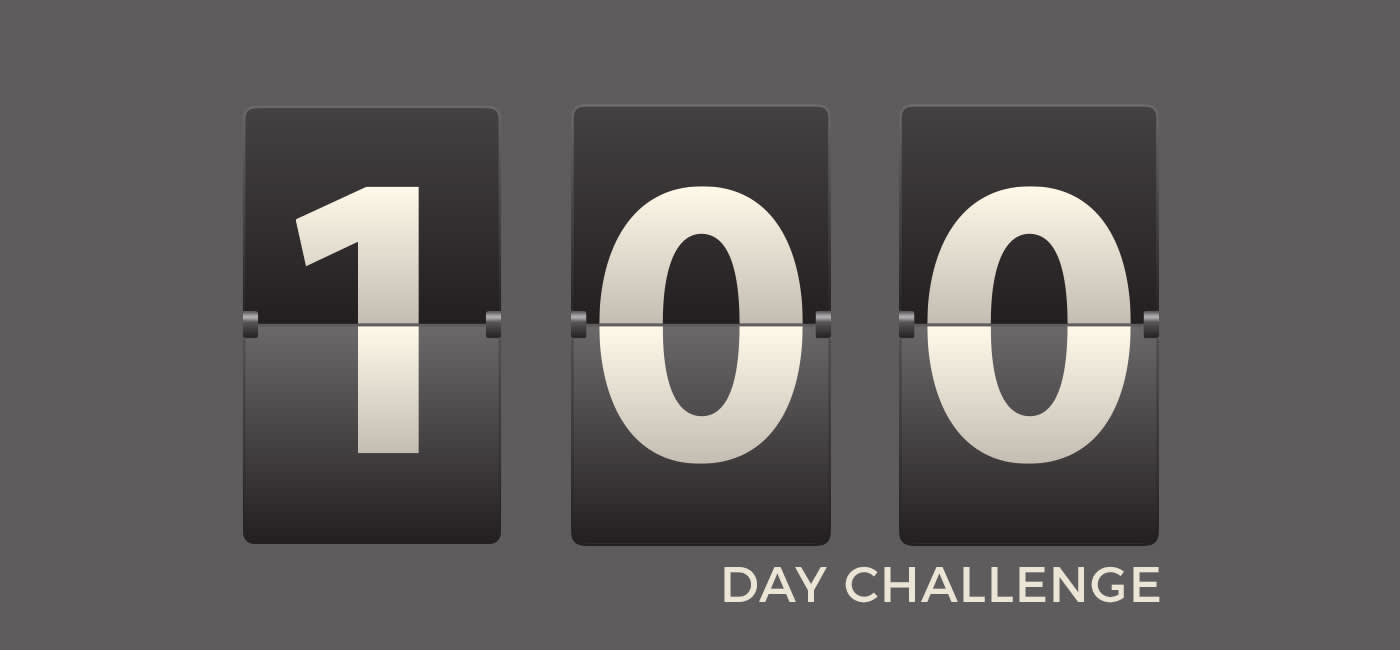
Every year, thousands of people all over the world set themselves the task of practising creativity for 100 days in a row. They either set their own challenge, spurred on by family, friends and social media followers, or take inspiration from #the100dayproject.
The idea behind the 100-day challenge is simple: find a creative project – whether it’s photography or vector illustrations – and do it every day for 100 days. Share your progress on social media along the way.
The best way to do this is to use a specific hashtag such as #100daysofvector or #100daysofillustration. If you’re taking part in the official #The100DayProject, other people taking part can follow your progress using that hashtag.
-
36 Days of Type challenge
Typography is a cornerstone of graphic design, but this challenge isn’t just about fonts and lettering: Barcelona-based Nina Sans and Rafa Goicoechea created 36 Days of Type as a personal project in 2014.
It has since become a renowned typography and graphic design challenge. Every day during the challenge, you’ll design your own take on the letters from A to Z and numbers from 0 to 9.
The challenge takes place once a year, usually between February and April. The exact start date is announced a few days in advance.
-
Behance Daily Creative Challenge
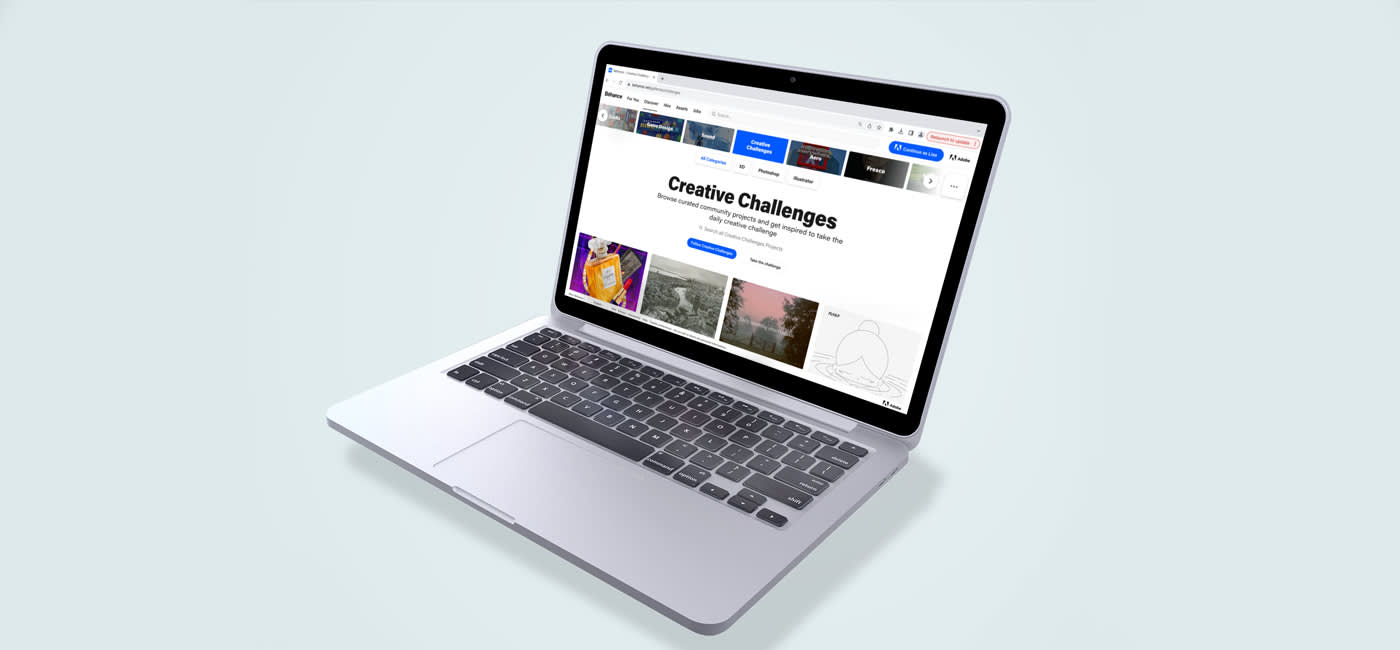
Behance is a social media platform from Adobe for creatives from a range of different disciplines. You can use it to present your portfolio and be inspired by other people’s work. You can also take part in the platform’s Daily Creative Challenges.
These help you showcase and improve your Adobe Xd and Adobe Photoshop skills. The challenges run for five days. They include a community chat, daily live stream and feedback from mentors and other people taking part.
-
DTIYS – ‘Draw This In Your Own Style’
DTIYS is an art challenge. You get an existing manga or comic illustration as a template and use it to do your own thing. It’s up to you whether you use a digital tool or a pencil and paintbrush. There’s no technical restrictions or time limit.
If you have your own ideas and want to draw a character in a different pose or change the colours, for instance, you’re free to do so. When you posting your version, use the hashtag #dtiysoff.
The project runs on Instagram and X, formerly known as Twitter, but also using the hashtags #dtiys #drawthisinyourstyle #dtiyschallenge #drawthisinyourstylechallenge and #drawinyourstyle.
The best graphic design games
If you’re too busy or not feeling bold enough for a design challenge right now, you can flex your creative muscles through play:
-
Color Method
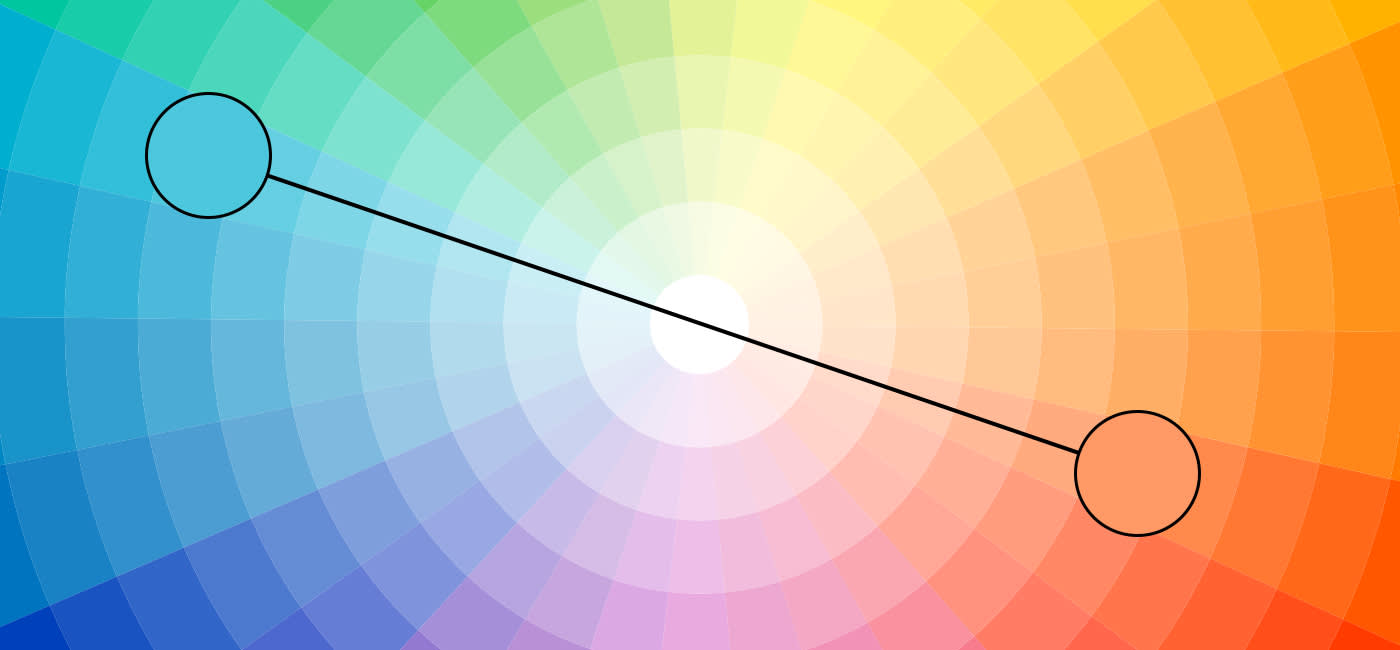
Can you colour us impressed? With Color Method, you can test and train your own colour perception in six different categories: hue, saturation, complementary colours, analogous colours, triadic and tetradic colours.
The game is played using an interactive colour wheel. The aim is to use the mouse to find specific colours and schemes on the wheel. The catch? You’ve only got 15-20 seconds to click the right colour.
-
Pixactly
How do your eagle eye and steady hand deal with pixels? Pixactly shows you specific pixel dimensions for length and width. You use the mouse and crosshair pointer to draw a box that matches these measurements as precisely as possible. This helps improve your accuracy when working with pixels.
The game has five rounds and you score depends on how close the boxes you draw come to the exact measurements. At the end, you’ll get an overall score and find out whether you excelled at working out pixel width or height.
-
The Bézier Game
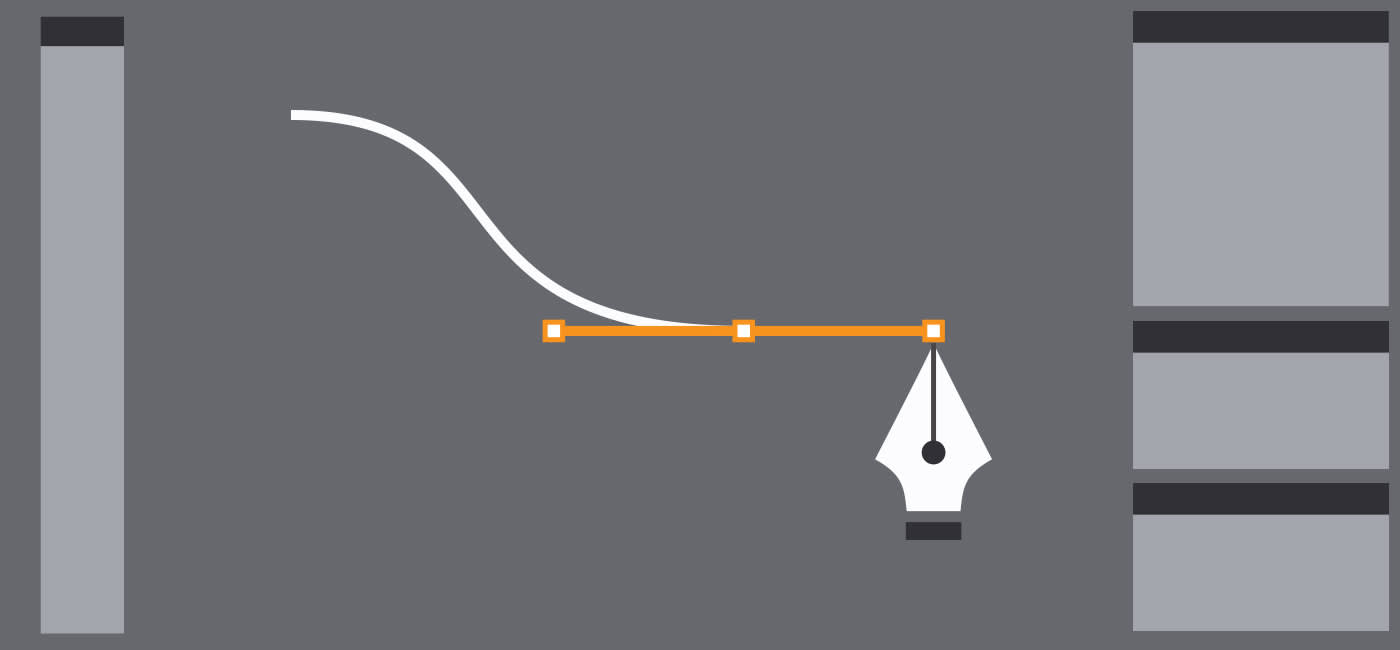
The Bézier Game follows a similar principle and helps you master using a pen tool. It’s a playful, low-stakes way to improve your skills with the pen tool found in Adobe Photoshop and Illustrator. It’s easy to play – simply follow the paths shown to create simple and more complex shapes.
-
Hex Invaders
Have you ever wished you could assign the right colour to a hex code straight away? That’s the challenge of Hex Invaders. The website simulates a video game interface. Your job is to destroy the invaders on your screen – by matching the hexadecimal code you receive to the right colour.
Sound complicated? Not to worry – the games shows you how to define hex codes for specific colours before you get started. This gives you an initial idea of what to do.
Got that creative spark and ready for your first – or next – design challenge? Wondering how you’d score in one of the design games? Then get started and let us know your creative workout goes!
The post The best graphic design challenges for training your creativity appeared first on The US Spreadshirt Blog.
Looking for cool gifts? Check Rott515 store!
Design trends 2023/24 – fall and winter inspiration
November 9, 2023tshirts,gifts,custom gifts,aviation,Custom Gifts,funny tshirts,funnyrott515
Life really does move that fast: the weather gets colder out of nowhere, and suddenly you’re back in your mid-season jacket. Don’t panic: we’ve scoured the length and breadth of the Internet and put together a rundown of the latest of trends for the coming months. Sit back, get comfy and be inspired.
Seasonal trend colours
Pantone colour trends 2023/24
This year, once again, it’s over to the Pantone Color Institute to present the latest on-trend colours and palettes. The defining theme in autumn and winter 2023/24 is the balance between bold, dynamic tones and neutral modern classics. Bright colours such as yellow, red and pink meet subtle, cool beige, white and grey tones. Check it out – and enjoy those creative colour names while you’re at it.
Vibrant autumn shades:
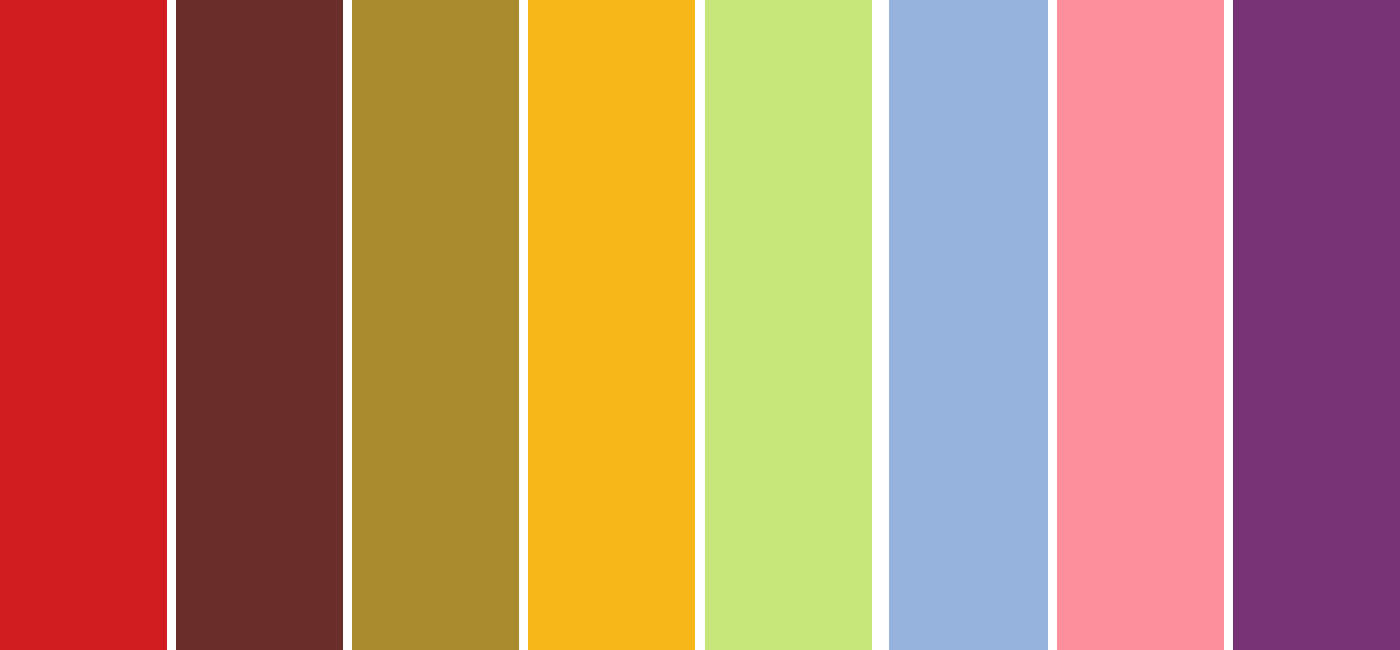
- Red:Fiery Red (PANTONE 18-1664 TCX) & Viva Magenta (PANTONE 18-1750 TCX)
- Orange: Coral – Persimmon (PANTONE 16-1544 TCX) & Red Orange (PANTONE 17-1464 TCX)
- Reddish brown:Fired Brick (PANTONE 19-1337 TCX) & Red Dahlia (PANTONE 19-1555 TCX)
- Yellow-green: Sharp Green (PANTONE 13-0535 TCX) & Kohlrabi (PANTONE 14-0255 TSX)
- Barbie/candy pink: Conch Shell PANTONE 15-1624 TCX
- Light blue: Lacecap Hydrangea (PANTONE 14-3921 TSX), Persian Jewel (PANTONE 17-3934 TCX), Blue Atoll (PANTONE 16-4535 TCX)
- Bright yellow: Spectra Yellow (PANTONE 14-0957 TCX)
- Gold-green: Olive Oil (PANTONE 16-0847 TCX)
- Lilac and purple: Sparkling Grape (PANTONE 19-3336 TCX) & Rose Violet (PANTONE 17-2624 TCX)
Classic, neutral tones:
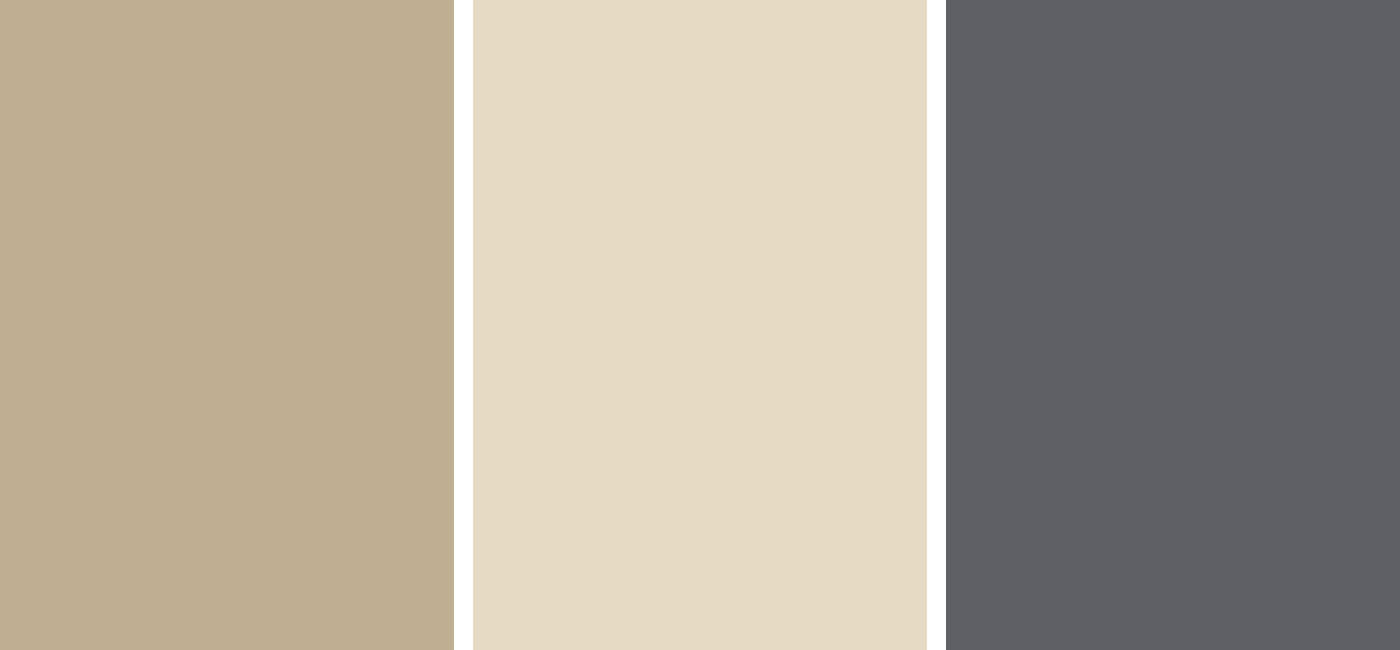
- Beige: Pale Khaki (PANTONE 15-1216 TCX) & Peach (PANTONE 12-0912 TCX)
- Dark green: Forest Night (PANTONE 19-0414 TCX)
- Cream white: Seedpearl (PANTONE 12-0703 TCX) & Coconut Milk PANTONE 11-0608 TCX
- Grey tones: Dark grey – Lava Smoke (PANTONE 18-0202 TCX) & Light grey – Nimbus Cloud (PANTONE 13-4108 TCX), Silver (PANTONE 13-4403 TCX)
The big six for the season ahead
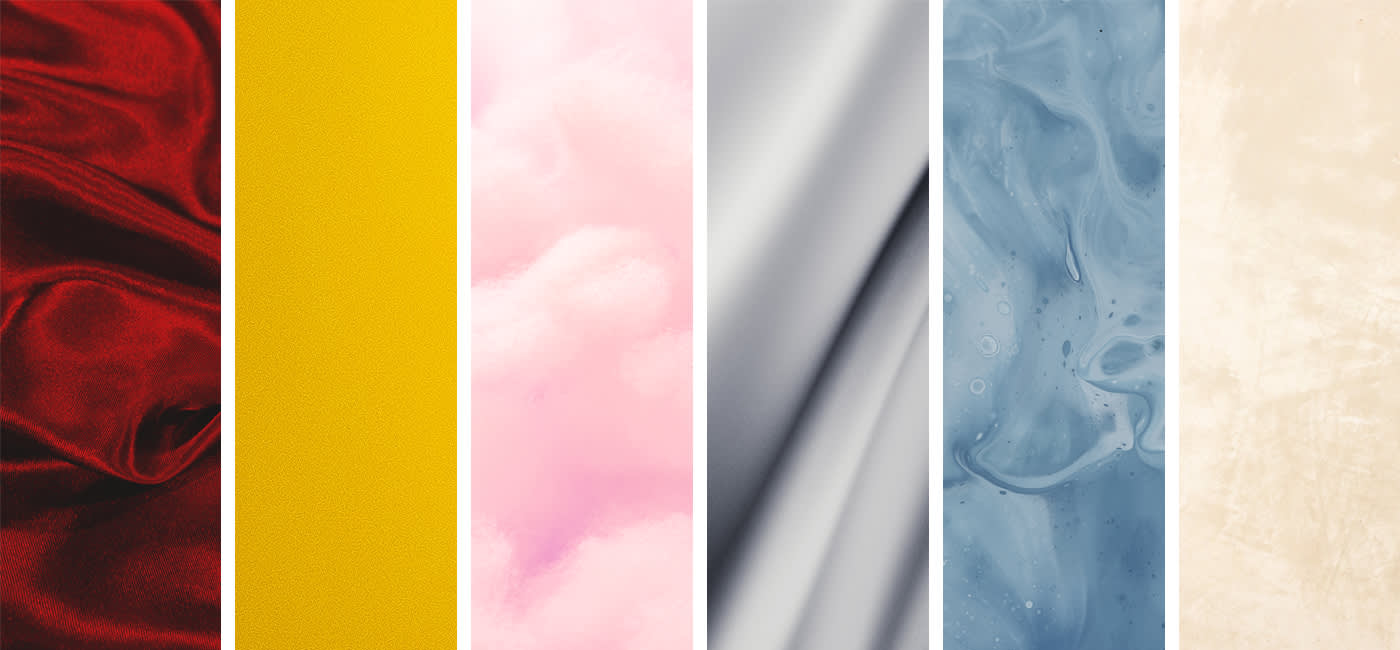
- Red: The style icon of the colour spectrum symbolises passion, energy and daring. In autumn/winter, the colour trend will be represented by Fiery Red, a bright and intense shade that catches the eye and boasts a strong emotional charge.
- Yellow: This radiant shade is this season’s undisputed hero. Yellow is a colour we mainly associate with warmth and bright sunshine. That’s why Pantone recommends a bright yellow with an intense brilliance for this time of year. It’s perfect for mixing and matching with neutral tones like black and white, as well as bolder colours such as red and emerald green.
- Candy pink: Summer’s Barbiecore trend has real staying power. A cute and playful touch gives your designs that unique soft feel. Powder and candy pink in particular are the on-trend shades for fall/winter. Candy Pink looks perfect paired with white, beige and black.
- Grey and silver (metallic): Grey is one of the most popular neutral colours as the weather turns colder. Lava Smoke grey, for instance, conveys a sense of subtlety and sophistication without the heaviness of classic black. It creates striking contrasts with colours such as pink, green or yellow.
- Blue: Dive into autumn’s icy waters. Blue is the perfect colour to add a touch of freshness and serenity to your designs. Blue Atoll and Lacecap Hydrangea are the most popular shades of blue for the autumn/winter season. Blue Atoll is currently becoming a true fashion trend for clothing and accessories, evoking the crystal waters that surround desert islands.
- Cream white: Unlike bright white, beige and cream white are slightly subtler, toned-down shades. Like the Pantone colour Coconut Milk, for instance, with its creamy white base. As it’s much softer than pure white, it looks great with other colours.
These blog posts have the lowdown on the best colour combinations and how to create a striking palette:
On-trend patterns and prints for autumn and winter
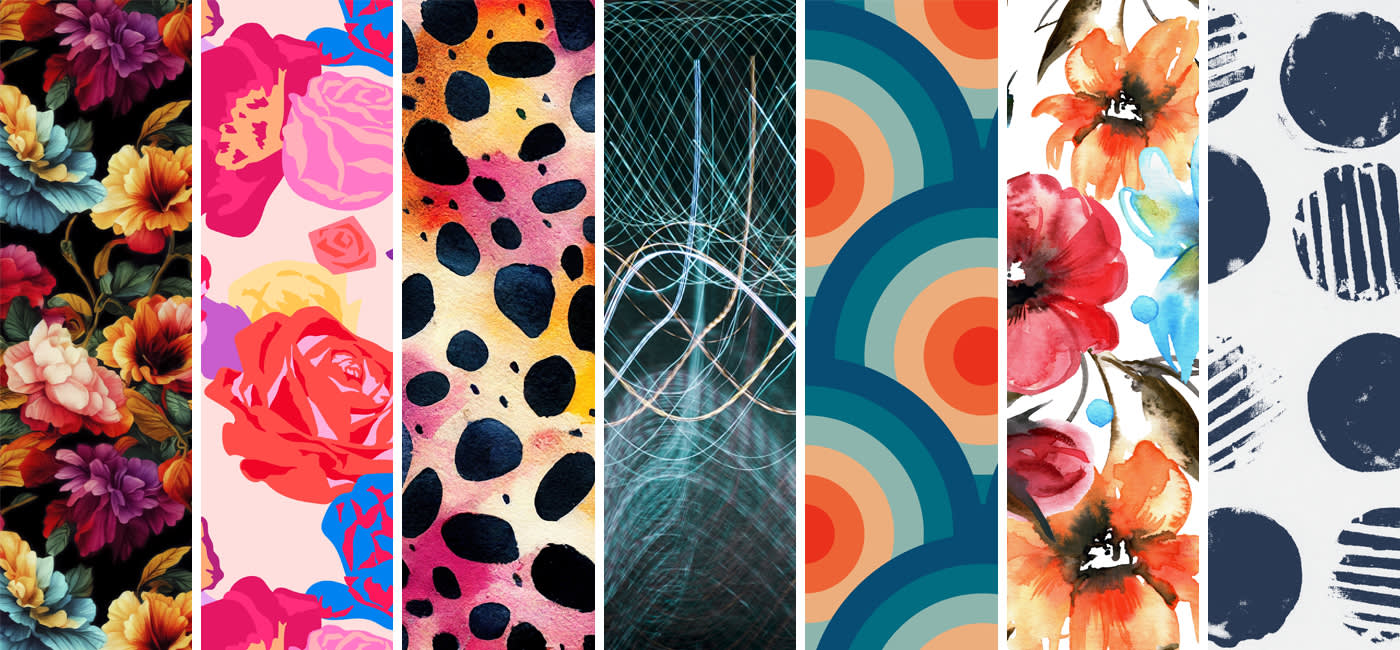
- Creative floral patterns: One of the top design trends for the season ahead. Impressionistic, in full bloom or inspired by nature – let your imagination run wild. A bright idea: use watercolour techniques for your own floral designs.
- Back to nature: These prints and patterns are inspired by the botanical world around us. From freshly picked flowers, beautiful blooms, smaller nature sketches and utopian visions of the future to chaotic, intense designs.
- Animal prints: Another top trend in prints and patterns this autumn/winter. Experimental and abstract animal patterns and colours, structured prints and new takes on classic animal prints are bang on trend. Spoiler alert: leopard print is always a hit – but this year you can dare to go beyond the natural colour scheme. How about a splash of neon, for instance?
- High voltage: Stay fully charged – with bold patterns powered by creativity. Experiment with intense, bright colours, neon highlights and prints with that electric feel. Feel free to turn down the contrast, too, and let your designs embrace a beautiful, kinetic blur.
- Links and weaves: These patterns use a mix of different structures. In a look inspired by retro designs, patterns are linked and interwoven to create lovely lattice effects. The colour palette stays subtle and muted.
- Pigmented flowers: Vibrant and full of life – these smudgy, hand-drawn blooms are bang on trend. Colourful hand-created contrasts such as dots and lines, simple, naive brushstrokes, structured layouts and playful geometric patterns are the design tools of choice here.
Short and sweet:
- Our top tips: opt for a LOT of colour, get to work with repeating patterns and dare to mix and match
- Create fun, expressive designs
- Hyper-realistic prints are a must
- Opt for floral motifs for bold and colourful highlights – the more creative, the better
On-trend styles and motifs for the months ahead
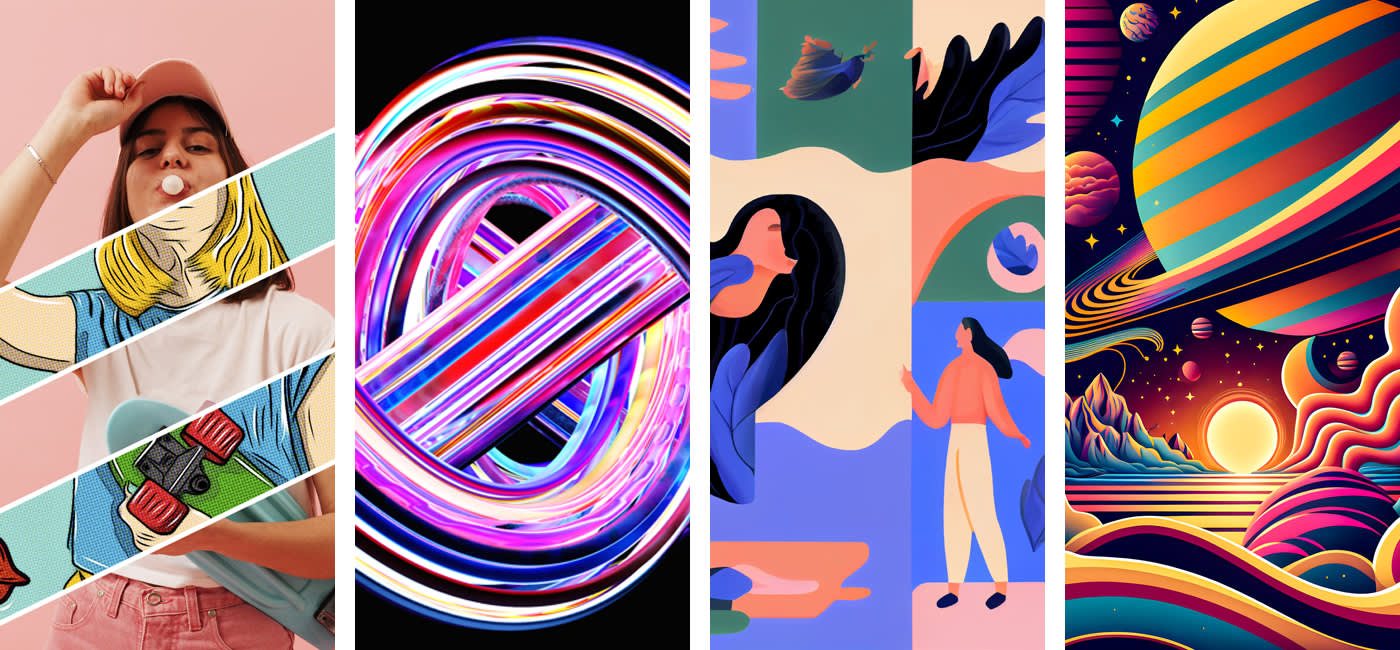
- Mixed dimensions: These designs blur the boundaries between real life and the digital realm. Simply combine photography with digital illustration, 3D elements and geometric shapes to create striking designs. It may seem dystopian and unsettling at first glance – but this look certainly has a smile on its face. Hilarious cartoons and bright colours offer broader perspectives on a photorealistic world full of surprises, curiosity and the joy of discovery.
- Acid graphics: Also known as Y2K grunge, acid graphics are the next stage in the ongoing Y2K revival. Hallmarks of this style include dirty, worn-out structures, chrome and metallic colours, broken patterns and amorphous shapes. This special twist on nostalgia evokes darkly stunning memories and is inspired by the late ’90s goth subculture.
- Complex compositions: In 2023, visual storytelling gets more literal AND more abstract with these compositions. These illustrations combine several scenes into one. You’ll find one figure taking photos, while another lazily paddles a canoe, and another climbs a mountain – just like in a hidden-picture puzzle. The trend doesn’t just catch the eye – it’s creative confirmation that we live in world of constant synchronicity.
- ’90s space psychedelia: Over the past year, we’ve seen ’60s-style psychedelic elements make a strong design comeback. This style creates bright and intricate worlds with a playful sense of escapism. Nineties space psychedelia is a new and spirited evolution of this trend. Instead of natural motifs like melting mushrooms and colourful clouds, the focus here is on linking past and future.
What a wild ride we’ve taken through the colours and patterns for the seasons ahead. Take a little time to decide which trends are right for your designs. You’ll find creative ideas and techniques to match here.
The post Design trends 2023/24 – fall and winter inspiration appeared first on The US Spreadshirt Blog.
Looking for cool gifts? Check Rott515 store!
Creative Halloween T-shirts for kids: a spooky guide for parents
October 16, 2023tshirts,gifts,custom gifts,aviation,Custom Gifts,funny tshirts,funnyrott515
Why self-designed Halloween t-shirts for kids are a real hit, what you should pay attention to when designing and how you finally get your self-created Halloween t-shirt – all will be revealed in this guide!
Conventional costumes are old hat: That’s why self-designed t-shirts are a hit!
Custom Halloween t-shirt designs offer numerous benefits for both parents and kids. They allow kids to wear unique and individual Halloween costumes that not everybody already knows. Halloween shirts are a great way to express kids’ personalities and interests. Unlike elaborate costumes, Halloween t-shirts are also great for everyday wear. Kids can wear them normally to school or daycare and not worry about ruining their expensive costumes.
Designing your own Halloween t-shirts for your kids offer a lot of advantages compared to traditional costumes. First of all, they allow for greater individuality. While store-bought costumes are often mass-produced, it’s not uncommon for several kids to show up in the same outfits, self-designed t-shirts, on the other hand, are unique. Best of all, kids can contribute their own ideas, which means they will personally identify with their costume and wear it proudly.
Another plus point is comfort. Halloween t-shirts are lightweight and comfortable to wear and are great for kids who are active throughout the day. Unlike bulky costumes, t-shirts allow for unrestricted movement.
T-shirts are also less expensive. Shop bought costumes can often be expensive, despite the low quality –and yet are usually only worn once a year. T-shirts, on the other hand, are durable and can be worn all year round on a variety of occasions.
Additionally, designing T-shirts encourages creativity and strengthens the bond between parents and children. It is a fun activity where ideas can be shared and implemented together. All in all, designing your own Halloween t-shirts give a unique opportunity to provide children with a personalized and convenient Halloween outfit.
Colorful, creative and individual: ideas for every gender and age
Of course, all of our design ideas are suitable for all genders. The following design ideas are wonderful for Halloween t-shirt design for boys and girls of any age:
• Monster Mash: Create t-shirts with scary monster faces and add some glow-in-the-dark eyes if necessary
• Skeleton: a simple skeleton design with eye-catching colors can be a frighteningly cool option
• Witch Princess: Create t-shirts with a mix of witch and princess elements, such as a witch hat and sparkly wand
• Fairy Creatures: Create t-shirts with glittery fairy wings and a magical fairy dust design
• Pumpkin magic: The normal pumpkin costume was yesterday. Decorate T-shirts with cheerful pumpkins that come to life on Halloween
• Creepy forest scene: create a t-shirt with a gloomy forest landscape inhabited by ghosts, bats and owls. Use glow-in-the-dark colors to make the designs really stand out
• Cute monster parade: create a t-shirt with an array of cute, yet creepy looking monsters happily standing side by side. They could have colorful fur, funny eyes, and creepy teeth
• Classic Scary: Design a t-shirt with iconic Halloween motifs such as pumpkins, bats, spiders and skeletons depicted in a vintage style. This gives the shirt a classic creepy charm
What to look for when designing kids Halloween t shirts?
When designing Halloween T-shirts, 3 important points should be considered:
• Choose products and colors that are suitable for children – you will find plenty in our assortment
• Make sure that the t-shirts are made of pleasant fabrics that are comfortable for kids to wear – we guarantee it!
• Make sure to use washable colors so that the T-shirts last longer
Why design your Halloween tee online
Use our Halloween t-shirt designing services. We guarantee a wide range of t-shirt styles and sizes to make sure you find the perfect t-shirts for your kids. Moreover, we offer user-friendly design tools that will allow you to easily implement your ideas. You’ll get your custom t-shirts conveniently delivered to your home, saving you time and effort. We also work with high-quality prints and materials to ensure that the t-shirts will last for a long time.
Step by step to your own Halloween T-shirt
Creating your own Halloween t-shirts through our online shop is a simple process:
• Choose the t-shirt style you want
• Choose a ready-made design or upload your own image
• Fine-tune: easily customize the design
• Review your order
• Enter shipping address and payment information
• Finalize your order
• Have an unforgettable Halloween party with the perfect outfit
That’s it! With these simple steps, you can design and order a custom Halloween t-shirt from Spreadshirt in no time. Now your little ghosts and witches can rock the Halloween party in unique outfits.
Design Halloween T-shirts turn heads at every party
Another invaluable advantage of self-designed Halloween t-shirts is that they will catch everyone’s eye at every costume party. Since they are so unique and original, they will attract attention and get people talking. The creativity that goes into designing these t-shirts can turn them into true works of art.
In addition, custom Halloween t-shirts much more budget-friendly, compared to store-bought costumes. Save money without sacrificing quality or the fun factor. These t-shirts are also durable and can be worn again year after year, making the investment even more worthwhile.
Customizing Halloween t-shirts is a great way to add to the fun of this spooky holiday. They’re comfortable, creative and personalized – just what little ghosts and witches need to take center stage and be remembered at any costume party. Use the fun of Halloween to create unique masterpieces with your kids and make this spooky night even more memorable.
Der Beitrag Creative Halloween T-shirts for kids: a spooky guide for parents erschien zuerst auf Create Blog.
Looking for cool gifts? Check Rott515 store!
Meet the Redbubble Artist Ambassadors
October 12, 2023tshirts,gifts,custom gifts,aviation,Custom Gifts,funny tshirts,funnyrott515
Looking for cool gifts? Check Rott515 store!
How to AI
September 24, 2023Custom Giftsgraphic design,design
Three approaches to deploying generative AI for brands and corporations.

History rhymes
This isn’t a trick question: 11 out of 12 in the image above are generated by AI. Which one is the real person?
I posed this quiz as an icebreaker for an executive meeting at a major, international brand. The CEO of this company had asked me to give a talk to their 20+ top executives about where AI is today and where it could go.
No one got it right.
After the talk at this Fortune 500 company, one executive commented, showing skepticism toward what AI could do for the company, its employees, and its business.
“Are we so busy that we need to rely on AI?”
Oh boy. My icebreaker didn’t land, did it? I was startled by this comment a little. That quickly subsided.
I’ve seen this script. History doesn’t necessarily repeat itself, but it rhymes.
Twenty-odd years ago, when I started my career in digital design, corporate executives, particularly in marketing, had similar skeptical stances towards digital. Even in the mid to late 2000s when there was a growing and healthy-size audience online, some marketers were still dismissive.
I was a “digital” creative director back then at a creative agency. Anyone above 40 in the industry would remember that our “digital stuff” used to be given a graveyard shift in a presentation deck. In one client meeting with a CMO, after the “traditional work” was presented over 45 minutes, it was the turn of the digital team.
“OK, digital. Cheap and quick stuff,” said the CMO chuckling.
Adopting early
Among the non-technology brands that I work with and what I hear from others, it’s a mix of elated embrace of and uneven interpretation of AI. Many of the brands that have embraced AI, particularly generative AI, have done so more for the sake of PR (like this, this, and this). To be clear and fair, this is not my criticism or cynicism. At least they are experimenting and experimentation can lead to unexpectedly good outcomes.
The others that haven’t are cautious because of data security, plagiarism, fake work, and unpredictable hallucinations. This is also understandable as these issues can have serious liability consequences.
There is general confusion around how to start and where to deploy AI, even though they know they should.
Embracing new technologies early has its upside as we’ve seen in the case of NFTs and the metaverse in the recent few years. At the same time, their success can descend as quickly as they ascend. Andreessen Horowitz, aka a16z, handsomely made billions of dollars from the early investment they made in cryptocurrency, NFT, and Web 3.0. At the same time, we all know that the market value of the same sector plunged by 90% in the last 18 months.
Making early bets and winning big, or else, is the business a16z is in. Most brands aren’t in that business.
The evolution of AI
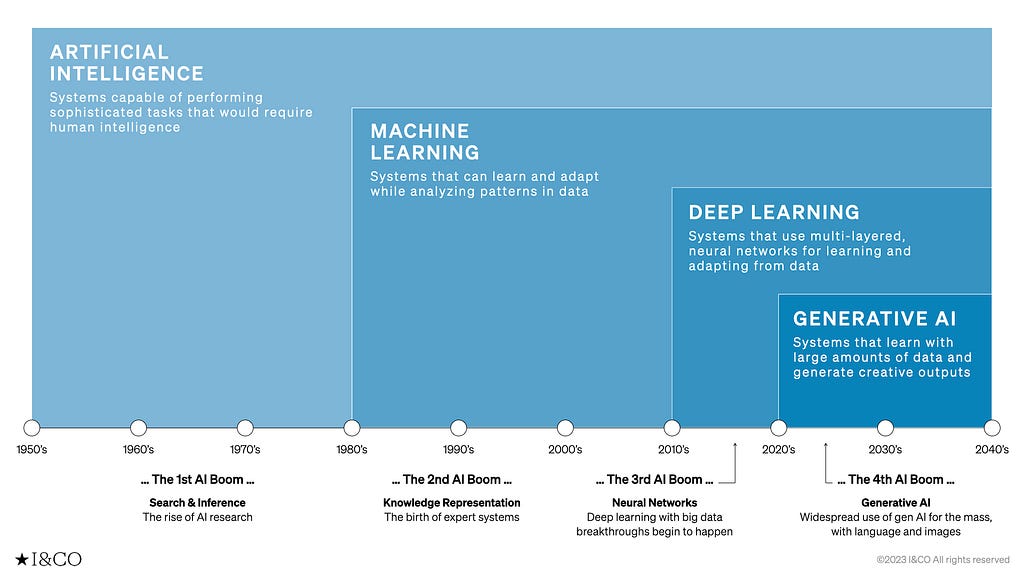
In 1955, then-29-year-old engineer Jonathan McCarthy used the term “artificial intelligence” in his writing. AI has been around the block for quite a while in various forms.
Up until several years ago, there was a varying degree of predictions around artificial general intelligence, or AGI-AI that is general enough that perform a wide range of tasks like a human instead of a specific one-and the possible timing of it becoming a reality. Some AI experts predicted it would be around 2030, others said 2050, and few predicted never.
ChatGPT, other LLM systems, and other generative AI tools may change that timeline more drastically than the experts thought.
Here’s a quick look at the several waves of AI evolution:
1st boom: 1950s — 1980s
- Artificial Intelligence: Systems capable of performing sophisticated tasks that would require human intelligence
2nd boom: 1980s — 2010s
- Machine Learning: Systems that can learn and adapt while analyzing patterns in data
3rd boom: 2010s — 2020s
- Deep Learning: Systems that use multi-layered, neural networks for learning and adapting from data
4th boom: 2020s — beyond
- Generative AI: Systems that learn with large amounts of data and generate creative outputs
The current AI situation is chaotic. However, as was the case with personal computers, the Internet, and smartphones, it is gradually converging.
It is an exciting time. There are numerous tutorials, classes, and self-proclaimed experts and gurus as well as optimists, pessimists, and skeptics. At an individual level, it is useful to start playing with the tools to see where it leads us. However, at a corporate level, it is necessary to frame the challenge we face in a strategic way to make some sense of the way forward.
I, with the help of my team, organize the current situation in the following framework: “Operation AI,” “Creation AI,” and “Transformation AI,” each of which will afford a benefit
Operation AI: A tool for improving efficiency to achieve “New Speed”
Creation AI: A tool that raises the average and elevates us to a “New Standard”
Transformation AI: A tool that transforms the status quo and allows us to reach “New Scale”
1. Operation AI
When talking about AI today, the most obvious and immediate area of deployment for corporations is operational. It gives us ways to gain efficiency in our daily tasks.
Such tasks include:
- Transcription
- Interpretation and translation
- Preparation of meeting minutes
- Text summarization
- Creation of slides, materials, manuals, etc.
- Sending emails
- Data analysis
Here’s one example of an operational use of generative AI to supposedly improve productivity:
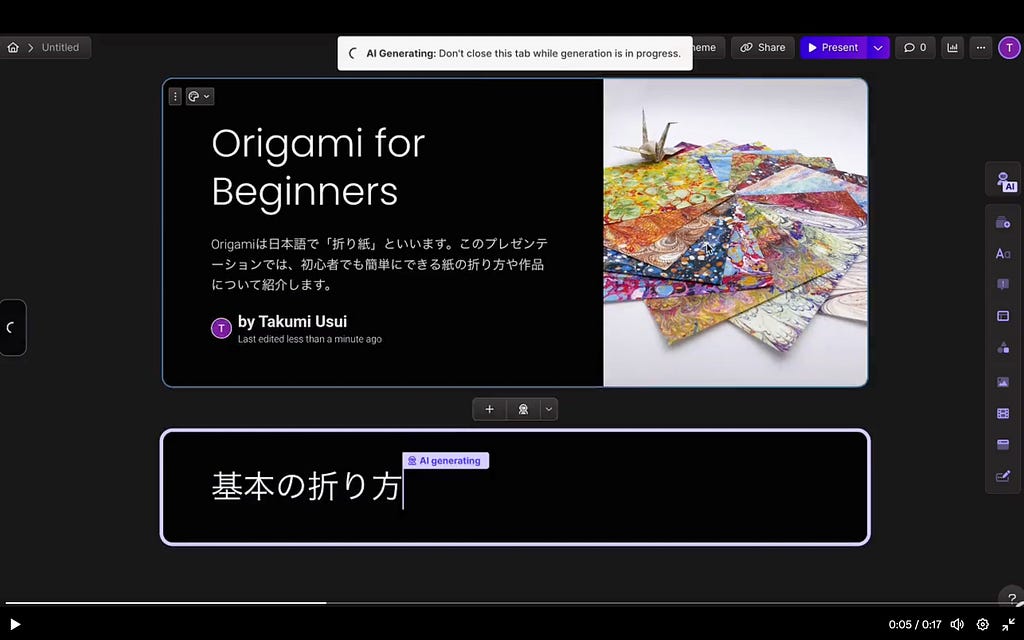
Gamma: AI for presenting ideas, beautifully
One of the Achilles heel challenges of generative AI is that it requires a massive amount of data. Big Tech companies like Google and Microsoft are at a major advantage as they have access to data and millions, if not billions, of people already using their productivity tools such as Word/Docs PowerPoint/Slide, and Excel/Sheet. Generative AI can be incorporated into this seamlessly.
If there are tasks that we are repeating, they probably can be replaced by AI.
Speaking of repeating tasks, image generation for e-commerce is one such area. Retail companies outsource that work to other more cost-effective vendors but that will be changing, if not already.
TryOneDiffusion, an initiative from the University of Washington/Google Research team, shows great and convincing promise for the very near future of an aspect of shopping.
What this tool does is to take two images-one, a person and the other, a garment worn by another person-and “diffuse” those two to “generate a visualization of how the garment might look on the input person.”
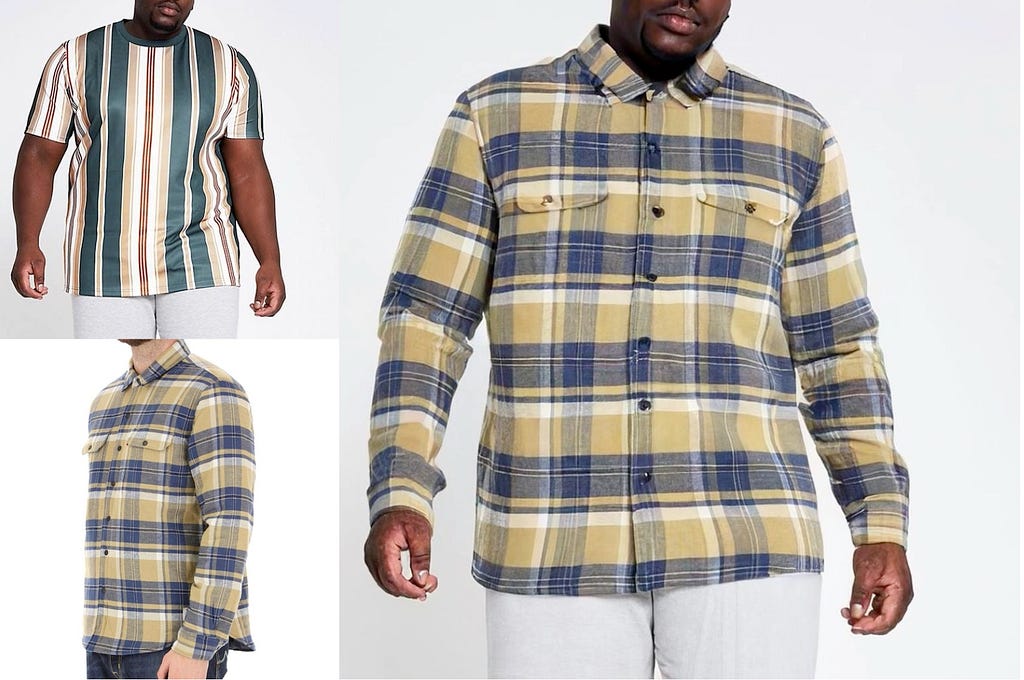
What this would allow retail brands to do is not just generate images of the products on the fly on various models but also what the product might look like on the customer.
Operation AI = New Speed
Operation AI brings “New Speed,” the kind of efficiency and productivity to us. The strength of AI is not that it gives correct answers, but that it gives us speed. Everything can be executed at high speed. However, that does not mean that it’s correct and humans do need to intervene to confirm the output.
2. Creation AI
Writing and visualizing used to be a skill reserved for humans. Not only did that change drastically with generative AI, but it’s also improving exponentially, as we’ve all seen in a comparison visual like this:
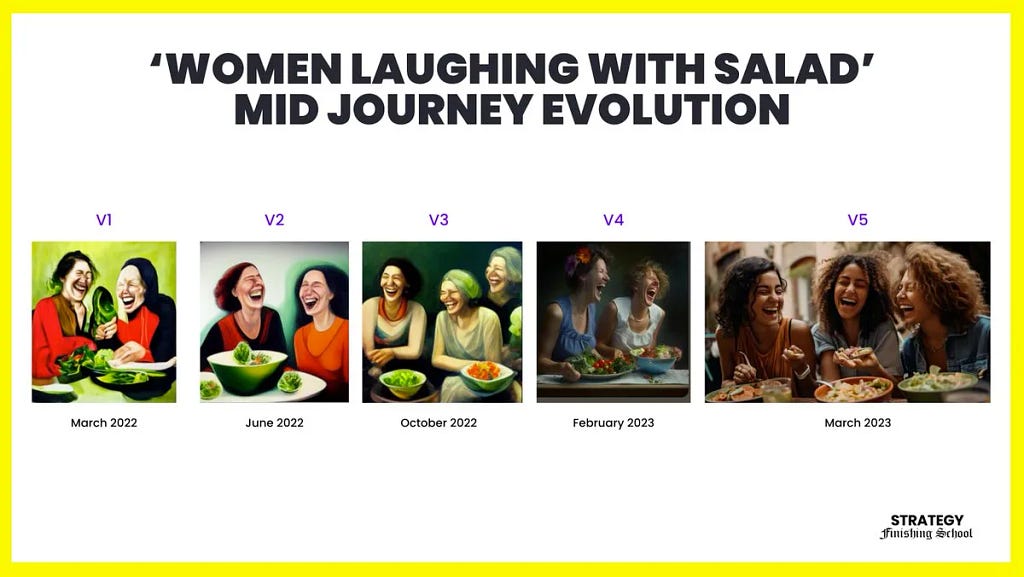
In addition, in understanding the current state of generative AI as it relates to creating various forms of content, this table from Sequoia Capital is useful in quickly getting a sense of where we are and where we are headed. This is, however, from September 2022, and given the speed at which AI is progressing, some of these predictions may be outdated.
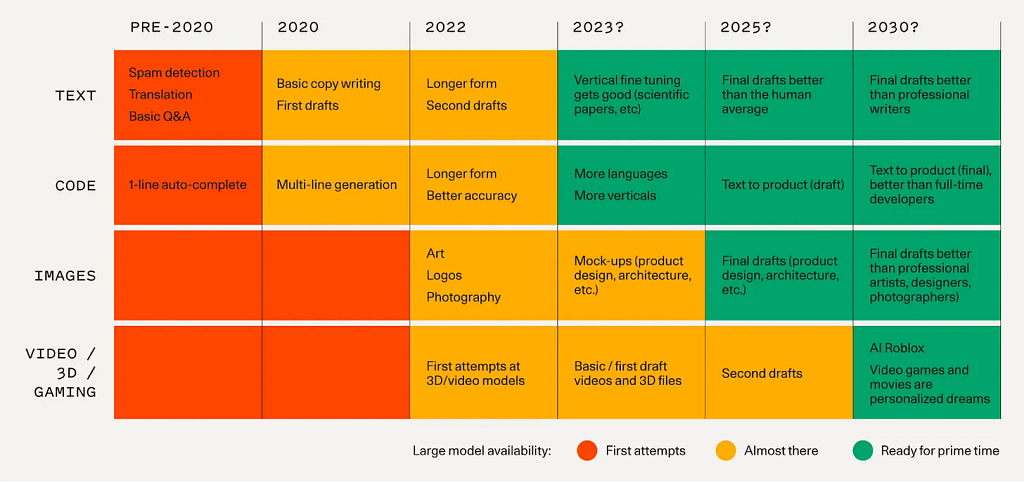
Some predict that the majority of content online will be synthetic shortly. That might also be true in the physical world sooner rather than later.
The *airegan line of sneakers is an experiment by independent designers and artists for now using generative AI to create endless options. We can easily imagine that there is already a new crop of brands we haven’t heard of that leverage AI to generate numerous designs based on what’s trending online.
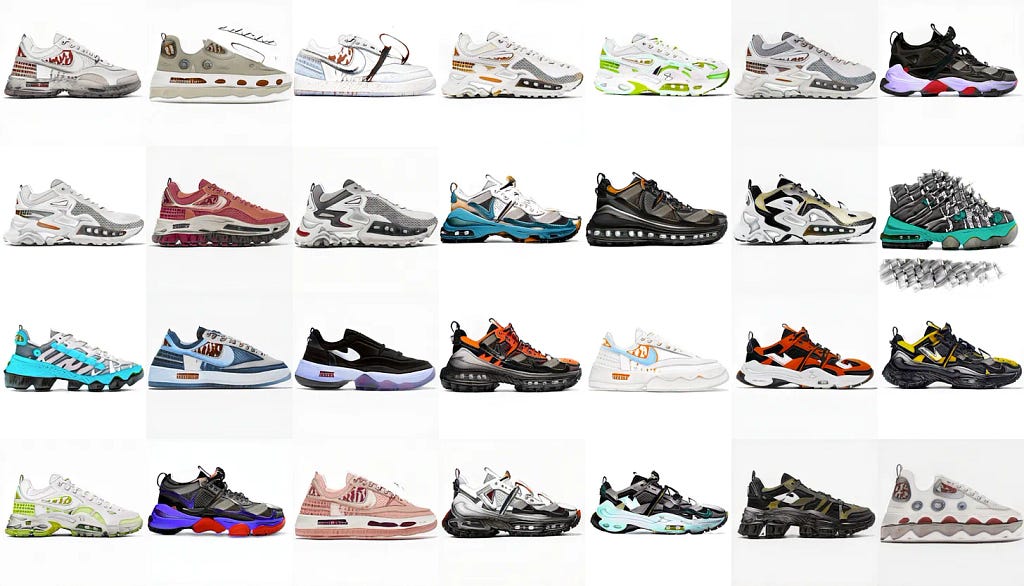
If quantity and variety are the selling point, like in fast fashion, Creation AI could prove helpful.
The next Shein is probably on its way.
The majority of generative AI tools tend to skew towards Operation AI rather than Creation AI. That is, they promise to increase efficiency rather than effectiveness. Taplio, a social media content creation and planning tool focused on LinkedIn is one such case I’ve seen. Its authoring tool, based on your original writing, suggests how to rewrite for better hooks and better engagements, and gives specific reasons why the rewrites it gives would be more effective, allowing the author to improve as they use the tool.
A recent collaboration between Claire Silver, an AI collaborative artist, and another fellow digital artist Emi Kusano is an attempt at imagining the new possibilities. One no longer needs to have design skills to be a designer. Silver says, “The barrier of skill is swept away. In this evolving era, taste is the new skill.” Silver and Kusano on their own may not have been able to create these images. That barrier is now indeed gone.
Jonas Peterson is another photographer who turned to AI recently for his work. Peterson’s strength as an image maker is the narrative he creates behind his work. His previous line of work was wedding photography, but if you look at his earlier, wedding photography work, it has a distinct feel that sets it apart from other run-of-the-mill photography out there. His photographs look like scenes from movies-which tools like Midjourney are decently skilled at producing based on prompts. He’s now using his taste to apply to AI art.
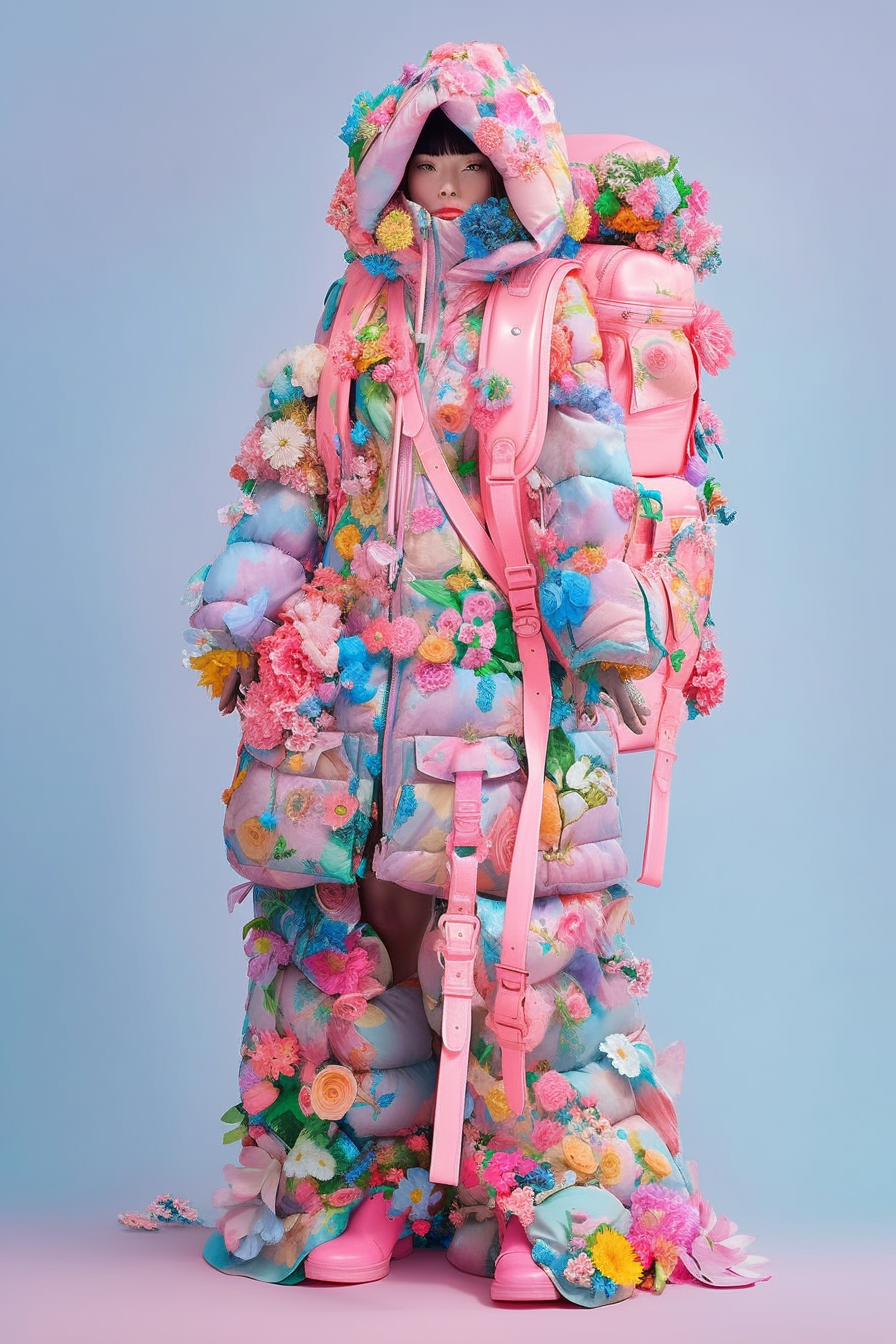
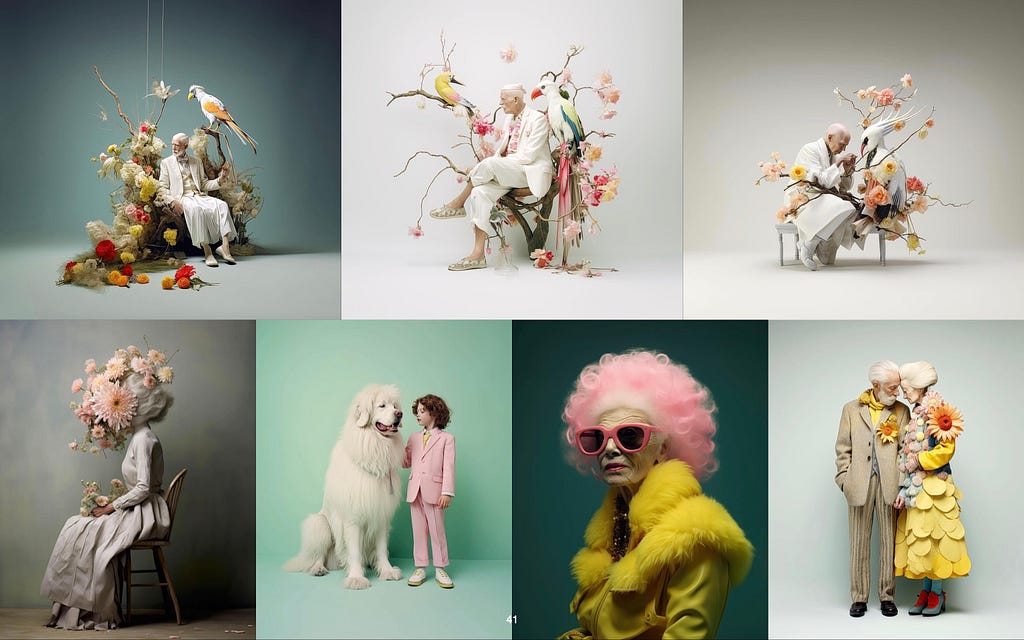
Creation AI = New Standard
Creation AI raises the bar, creating a “New Standard.” Creation AI’s strength is not in generating ideas, but in raising the average that humans can create. It democratizes and de-industrializes creativity.
3. Transformation AI
The opportunity that generative AI affords us is to rethink how we can operate our businesses and transform them.
Throughout the centuries, we have seen transformations in media and how we relate to the world around us.

What this evolution brings to brands and corporations is that, in addition to the New Speed and the New Standard, it also allows us to reach the kind of reach and scale never possible before.
In the Age of the Internet and Mobile, technology allowed not only corporations to connect with individuals, we were able to connect with brands on our terms. What each of us saw from a brand, however, was mostly the same. That’s because the communication was either mass-produced, templated, or pattern-matched.
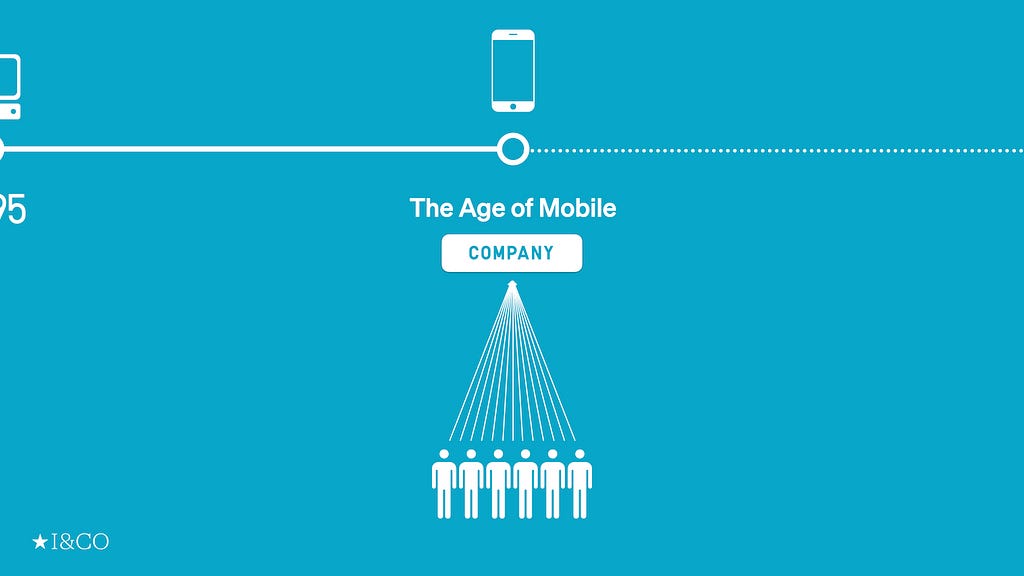
This can change radically in the age of AI.
The representation of a brand no longer needs to be singular. A brand can-and should- have one, consistent voice, but with it, it can also cater to the individuals separately and specifically.
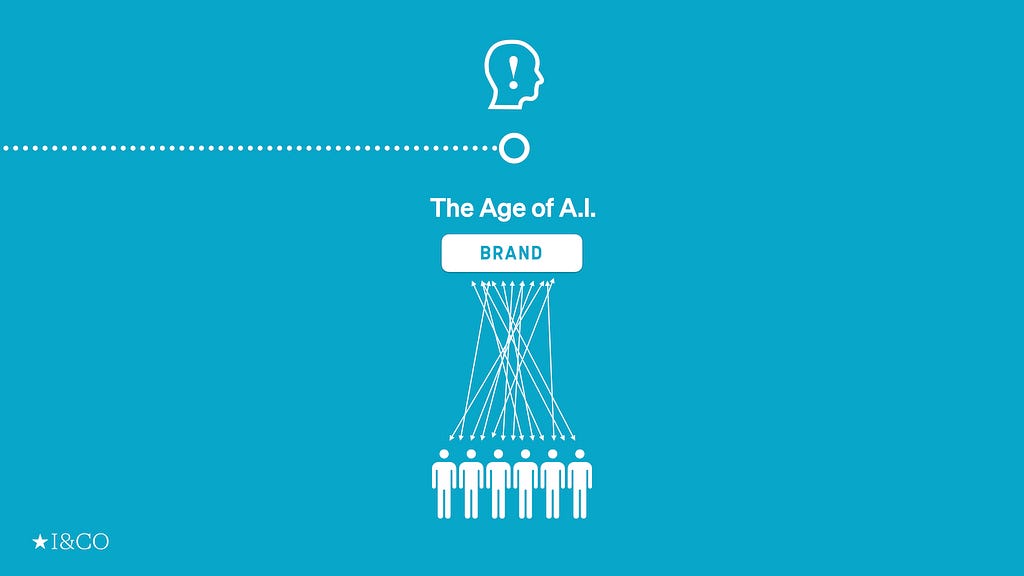
Take Hybe, the Korean entertainment juggernaut behind enormously successful BTS and other K-pop groups, as an example. They announced the first single “Masquerade” from MIDNATT, a new artist that the label is backing. What was new and unique about this debut song is that it was produced in six different languages: Korean, English, Japanese, Chinese, Vietnamese, and Spanish.
It’s a good example of a partnership between humans and machines to achieve reach. By releasing the song in multiple languages, Hybe is enabling the kind of scale for its artists that wasn’t possible a few years ago.
This isn’t specific to the individuals, and it probably doesn’t and shouldn’t be. A song from an artist is something we share and we aren’t looking for some hyper-personalization.
Let’s take this another notch by the thousands.
During the UEFA Champions League Final, Adidas created a fan experience by transforming football legend Alessandro Del Piero into their personal newscaster and commentator. Using WhatsApp AI, fans could chat directly with Del Piero and they would receive LIVE updates and replies instantly from the star himself, or the AI version of Del Piero. It was at a scale that was never possible before: over 44,000 messages in 10 seconds.
The idea of personalization has been around for years now. However, personalization executions have mostly been about serving pre-generated content to the individual user based on the tracking of their previous patterns.
Similarly, Chris Do, a design entrepreneur with more than a million followers on social media who helps designers become better business people, is creating an AI version of himself to allow him and his team to serve a much bigger audience with a credible replica of Chris himself.
This type of deployment of generative AI makes true personalization possible in that it’s not based on the user’s prior behavior or engagements. In addition, AI makes it possible to tailor that unique interaction to mass and scale instantly like never before.
Transformation AI = New Scale
Transformation AI can give us the kind of reach, “New Scale” by allowing us to do more with less. Transformation AI’s potential is to help us grow our business without growing our organization significantly. It scales our reach way beyond our individual as well as organizational capability. It could transform the way we manage our business.
The answer is…
Back to the icebreaker quiz: Most people think #7 is the real person, followed by #4. The answer is #5. The tell is her ears and earrings. For generative AI, ears are, similarly to the fingers, apparently difficult to render. If you look at #5, her ears and earrings are accurately and realistically shown. Well, it’s a real photograph.
This image is courtesy of Imagenavi INAI Model, a Japanese imaging company that started offering a virtual modeling service using AI to replace human models with generated models. The real photo is by Jimmy Fermin.
I also asked at the aforementioned meeting, other than ChatGPT, if anyone had tried using generative AI tools such as Midjourney, Stable Diffusion, or others. Most hadn’t and I don’t blame them. The interfaces of some of these tools are still pretty atrocious.
One of the issues of newer technologies like VR and the metaverse that’s stopping mass adoption, I believe, is the interface. For them to become widely adopted, the interface needs to be so simple, like ChatGPT or the iPhone, that anyone can use it without manuals or tutorials.
Unlike the metaverse or NFTs, generative AI is here to stay. Enough applications of generative AI are becoming available literally on a daily basis. In sum, the three approaches to deploying generative AI for brands and corporations are:
Operation AI: A tool for improving efficiency to achieve “ New Speed “
Creation AI: A tool that raises the average and elevates us to a “ New Standard “
Transformation AI: A tool that transforms the status quo and allows us to reach “ New Scale “
Having said all of this, I do sympathize with the executive’s skepticism, at least partially. As much as I do rely on ChatGPT, Claude.ai, Midjourney, and other AI tools for various tasks throughout the day, I—and not AI—am still writing this newsletter entirely by myself, occasionally with some help from other humans at my company.
If you knew it was being written by ChatGPT, would you still read it?
Special credits & thanks to I&CO’s Daiki Kanayama, Takashi Mazawa, Riho Nishimoto, and Shohei Kubota for the research
Thanks for reading. If you like what you read, please subscribe to the The Intersection newsletter.
Originally published at https://reiinamoto.substack.com.
How to AI was originally published in UX Collective on Medium, where people are continuing the conversation by highlighting and responding to this story.
Looking for cool gifts? Check Rott515 store!
Custom T-shirts for a Beer Festival
September 22, 2023tshirts,gifts,custom gifts,aviation,Custom Gifts,funny tshirts,funnyrott515
Anyone can wear dirndls and lederhosen
Admittedly, dirndls and lederhosen are the classic outfits for the festivities and look fantastic. However, practically everyone wears these outfits.
While dirndls and lederhosen are undoubtedly charming and steeped in tradition, they offer limited opportunities for personalization. Sure, everyone wearing them may look good, but perhaps you want more than just “looking good.” Designing a custom Beer Festival T-shirt allows you to unleash your creativity and express your unique style in a one-of-a-kind way.
Infuse your outfit with a personal touch
A tailored T-shirt can say a lot about your personality. Whether you have a favorite color, love specific patterns, or simply want to showcase your sense of humor – a self-designed Beer Festival T-shirt provides a canvas for expressing your uniqueness. It becomes a conversation piece at the Munich Beer Festival, allowing you to make new friends who share your interests and style.
Show your group affiliation with a self-designed Beer Festival T-shirt
When you’re out with a group of friends, wearing individually designed T-shirts can create a strong sense of community. Each T-shirt can feature a common motif or phrase that emphasizes your togetherness and makes the party even more memorable. Nothing creates a closer bond between a group than the feeling of sharing something special and unique.
Instead of blending into the crowd, you can stand out at your local Beer Festival with a T-shirt that highlights your individuality and celebrates the true spirit of the festival in your own style.
Designing Beer Festival T-shirts: Great for groups and bachelor parties
Wearing matching Beer Festival T-shirts is not only a way to strengthen the sense of unity but also to create lasting memories that will stay with you for a lifetime. When you and your friends or bachelor party group attend a Beer Festival, you’re sure to have a wealth of experiences and adventures. The matching shirts become a symbol of this special time and serve as a reminder of the fun moments you shared together.
Also practical: Easier group identification
At any Beer Festival, it’s easy to lose track of your group amidst the sea of dirndls and lederhosen, especially when it’s crowded. Matching T-shirts not only make it easier for you to find your group but also for others who may be trying to locate you. Your unique group design will stand out and help you reunite quickly in the bustling crowd.
Pure anticipation!
Designing the T-shirts and choosing a common design can be a lot of fun, allowing you to unleaseh your creativity before the big event. It’s a great way to build excitement for the festival and make joint decisions that will make the group experience even more special.
Unforgettable photos thanks to custom T-shirts
Memorable photos are an essential part of any Beer Festival visit. With your unique group T-shirts, you won’t just stand out in photos; they will also be a lasting memory of the joy you shared together.
Whether you’re posing in front of the Ferris wheel or lifting the festival’s biggest beer glass, your shirts will make the photos unmistakable.
Funny and creative Beer Festival T-shirts for groups and bachelor parties are not only a fashion statement but also a way to strengthen the sense of community, create memories, and elevate the fun to the next level.
So, grab your friends, design a unique shirt, and get ready for unforgettable moments!
Ideas for designing your individual Beer Festival T-shirt
Before you get started, think about which design best suits you and your style. Here are some ideas to help you design your Munich Beer Festival T-shirt:
Beer Festival T-Shirt: Design Ideas
Choose a motif that suits the Munich Beer Festival atmosphere. Traditional symbols like pretzels, gingerbread hearts, beer mugs, or Bavarian flags are always a good choice. Or dare to be different and incorporate your own creative ideas.
Sayings for your Munich Beer Festival T-shirt
A witty saying or a quote in Bavarian dialect on your shirt can bring plenty of smiles. Think of something that lifts the mood and makes the people around you chuckle.
Inside jokes for Munich Beer Festival enthusiasts
Perhaps there’s something that only Munich Beer Festival enthusiasts understand or that specifically brings laughter in your group? If you’re a true fan, you probably know some inside jokes or anecdotes about the festival. Use them in your design, and you’re sure to find like-minded people who will smile along.
Traditional Beer Festival T-Shirts for Women – Design Ideas
For women, there are countless ways to design a custom Beer Festival T-shirt. Here are some design ideas:
● Flower wreaths and hearts: Adorn your T-shirt with pretty flower wreaths and hearts to create a romantic look.
● Glitter and sequins: A touch of glitter and glamour never hurts. Use glitter colors and sequins to make your T-shirt shine.
● Vintage style: You can also opt for a vintage look that harks back to the roots of the original German Beer Festivals.
Beer Festival T-Shirts for Men – Design Ideas
There are also plenty of options for men to design a custom Beer Festival T-shirt:
● Bavarian beer motifs: Show your love for beer with beer mug motifs or beer barrel designs.
● Funny sayings: Men love humor. Choose funny sayings or wordplay that will guarantee laughter from your friends.
● Retro designs: A retro design featuring old beer advertisements or classic cars can add an interesting touch to your T-shirt.
Design and print your Beer Festival T-shirt
Designing your Beer Festival T-shirt can be fun, but if you don’t have the necessary skills or tools, don’t worry!
With us, you can upload your desired designs and motifs, select the size and color of the T-shirt, and place your order. In no time, you’ll have a unique Munich Beer Festival T-shirt in your hands that perfectly complements your Munich Beer Festival party. Just check out our online shop. There, with a few clicks and lots of fun, you can design your personalized Munich Beer Festival T-shirt.
Designing an individual T-shirt is a great way to express your personality and passion for the folk festival. Whether you do it yourself or seek professional help, your own custom tee will undoubtedly be an eye-catcher at your next Beer Festival and all future ones and create many unforgettable moments. Cheers!”
Der Beitrag Custom T-shirts for a Beer Festival erschien zuerst auf Create Blog.
Looking for cool gifts? Check Rott515 store!
The Most Searched Terms October to December 2022
September 19, 2023tshirts,gifts,custom gifts,aviation,Custom Gifts,funny tshirts,funnyrott515
Our top 10 most searched terms for for the US, Australia and Canada offer you an insight into essential trends and topics. Use this knowledge to make your designs more on point this year. How exactly? Simply tag your already uploaded designs with the relevant search terms or create new designs which match up with trends from this period last year.
United States
Top 10 Spreadshirt Searches
- Christmas
- Funny
- Halloween
- Sport
- Fall
- Family
- Travel
- Dog
- Vintage
- Funny Christmas
Top 10 Google Searches
- Happy Diwali
- Pastina
- Graffiti letters
- Happy Thanksgiving
- I love my girlfriend
- Cute potato
- Super strikers
- Cute panda drawing
- Happy Halloween
- Dance
Canada
Top 10 Spreadshirt Searches
- Canada
- Funny
- Humour
- Christmas
- Hockey
- Halloween
- Vintage
- Funny Christmas
- Ugly Christmas
- Beer
Top 10 Google Searches
- Every child matters shirt
- Electrician
- Cube rubik
- Gymnastique
- Squirrel
- Cheval
- Ski-doo
- Hockey hoodies
- Penguin
- Canada hoodie
Australia
Top 10 Spreadshirt Searches
- Christmas
- Funny Christmas
- Ugly Christmas
- Australia
- Gaming
- Halloween
- Geek
- Wolf
- Anime
- 80’s
Top 10 Google Searches
- I’m sexy and I mow it
- Ugly Christmas sweater
- Christmas jumpers
- Yeah nah shirt
- Inappropriate Christmas shirts
- Vintage
- Naughty Christmas
- Cruise shirts
- Breast Cancer T-shirts
- Geek T shirts
Need some more drive to get you going? Our article on special occasions October to December 2023 will be sure to get you on the right path.
If you still have questions, we’re happy to answer them in the comments below this article or in our Forum.
The post The Most Searched Terms October to December 2022 appeared first on The US Spreadshirt Blog.
Looking for cool gifts? Check Rott515 store!


